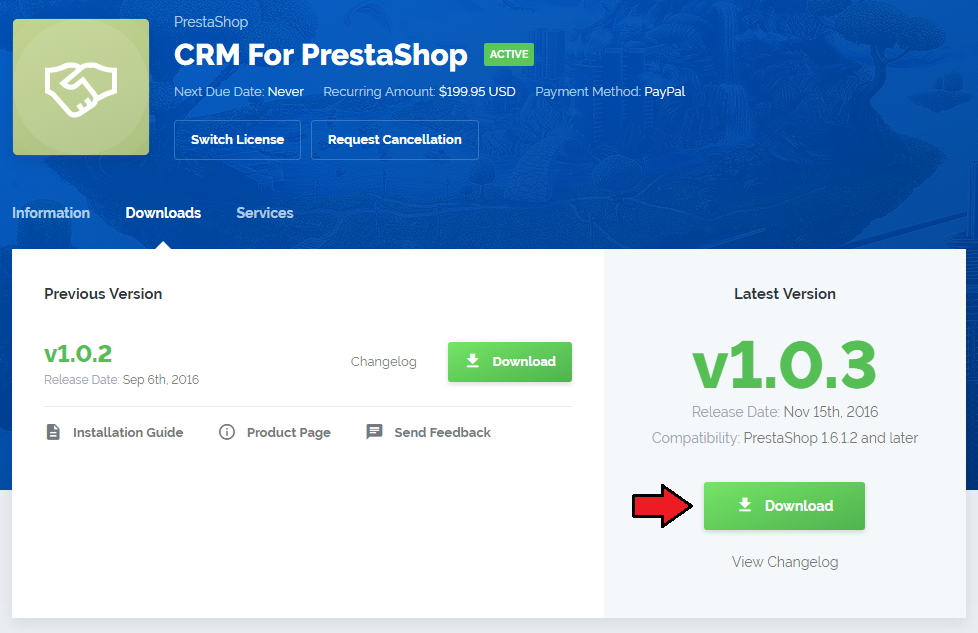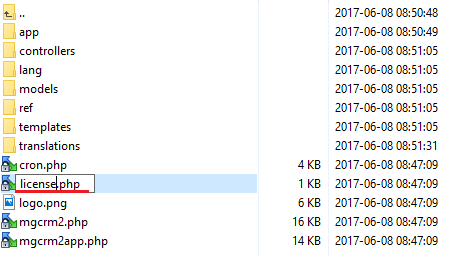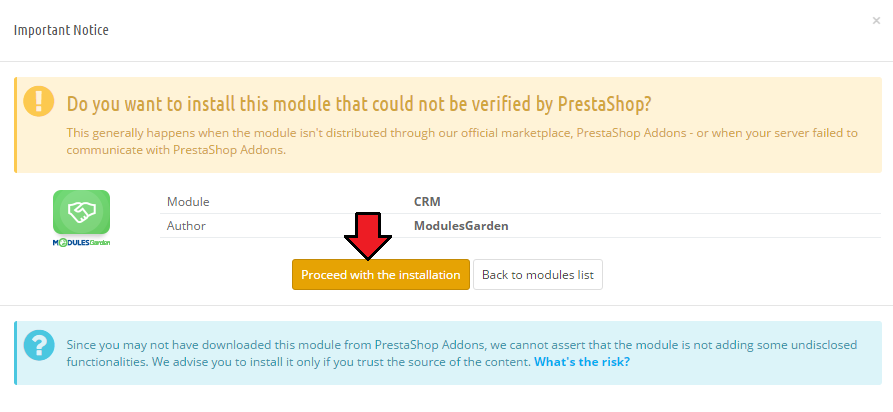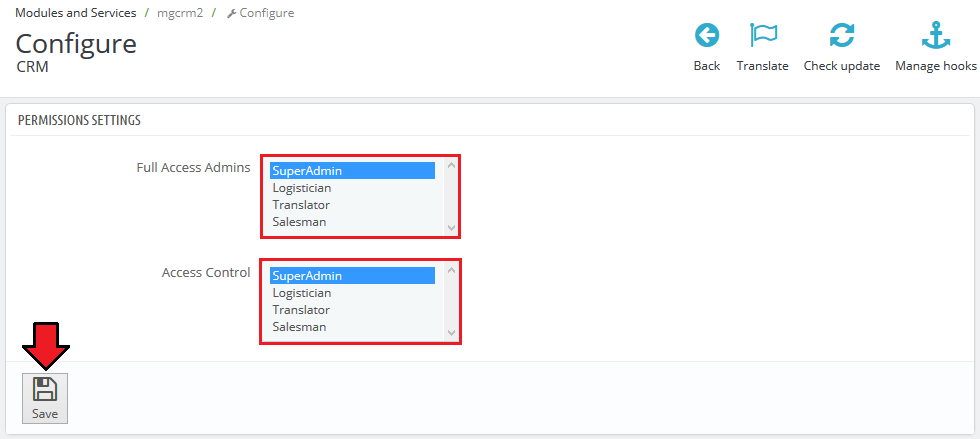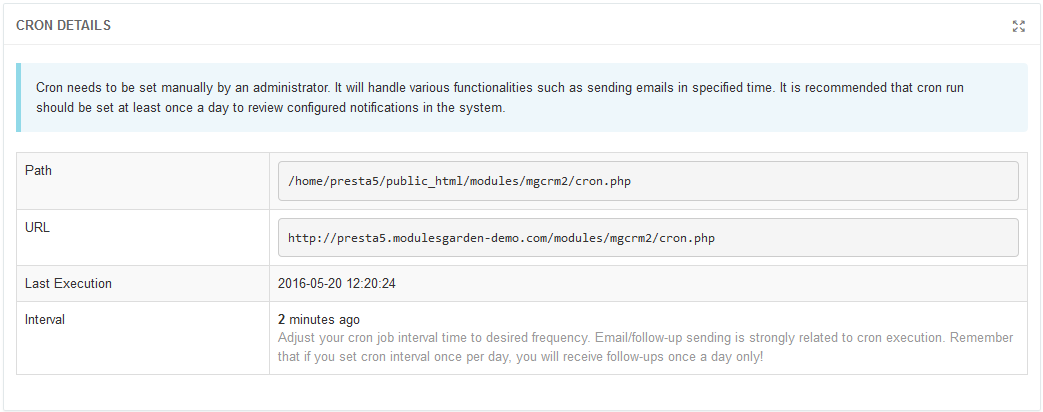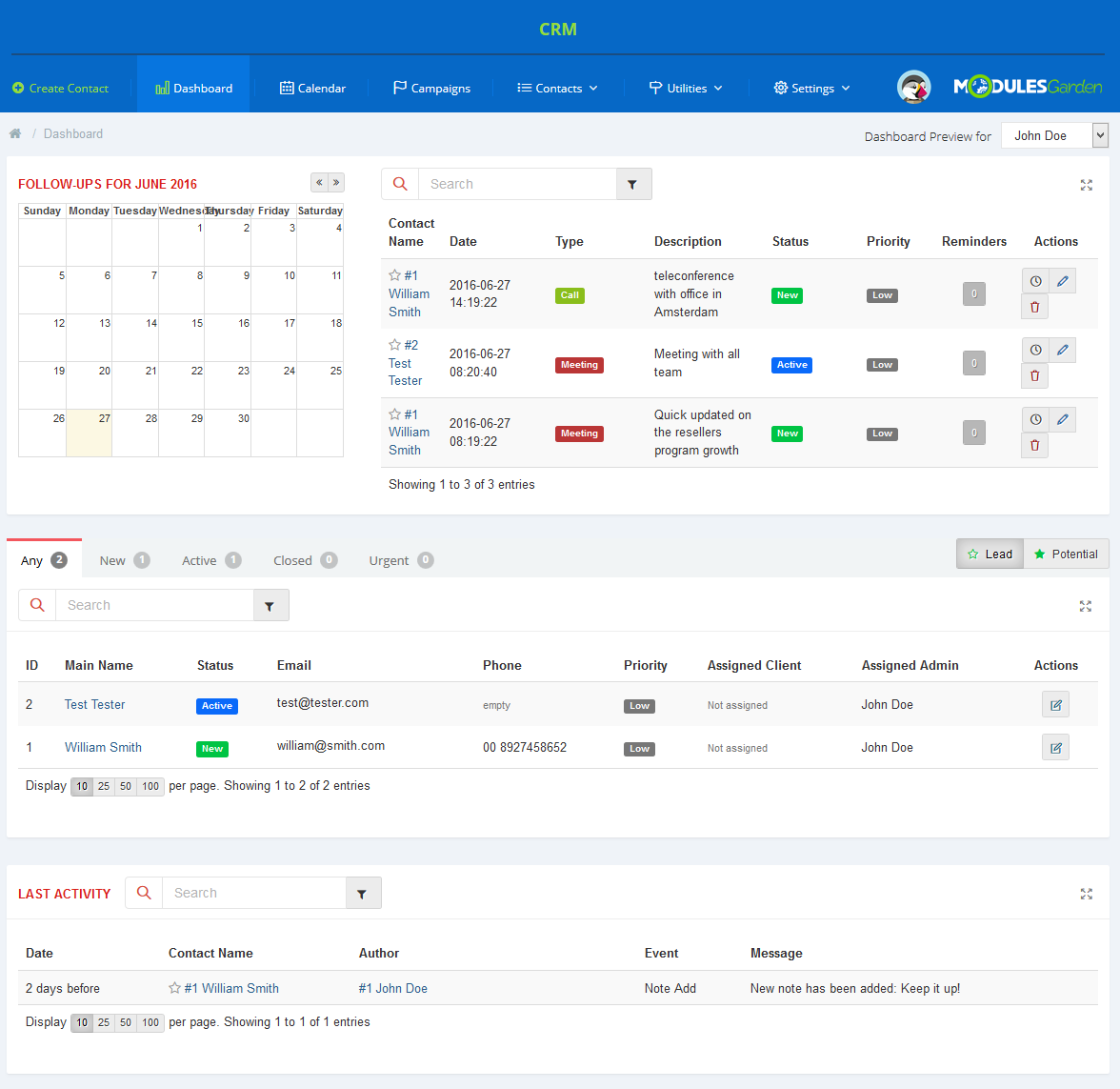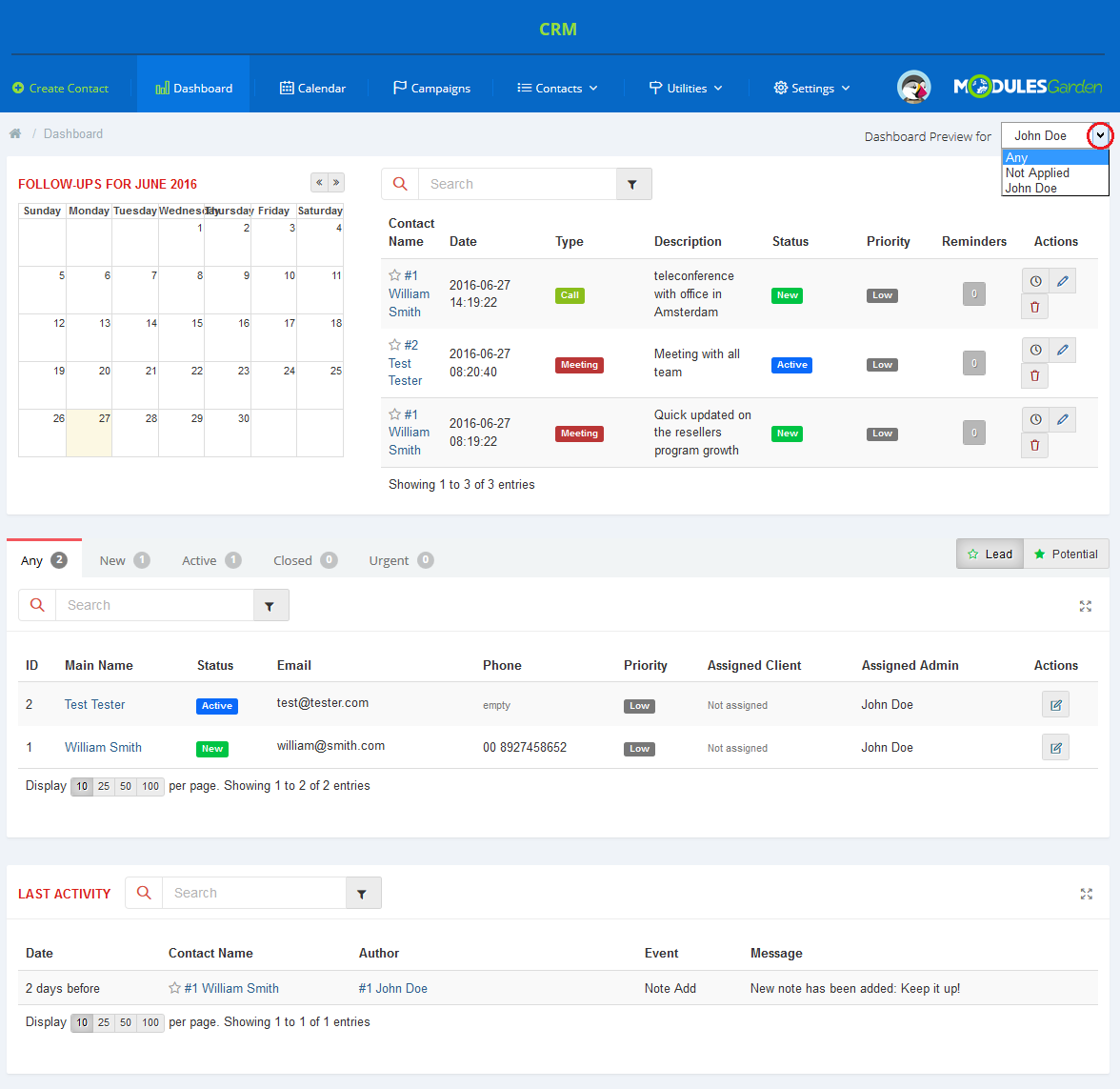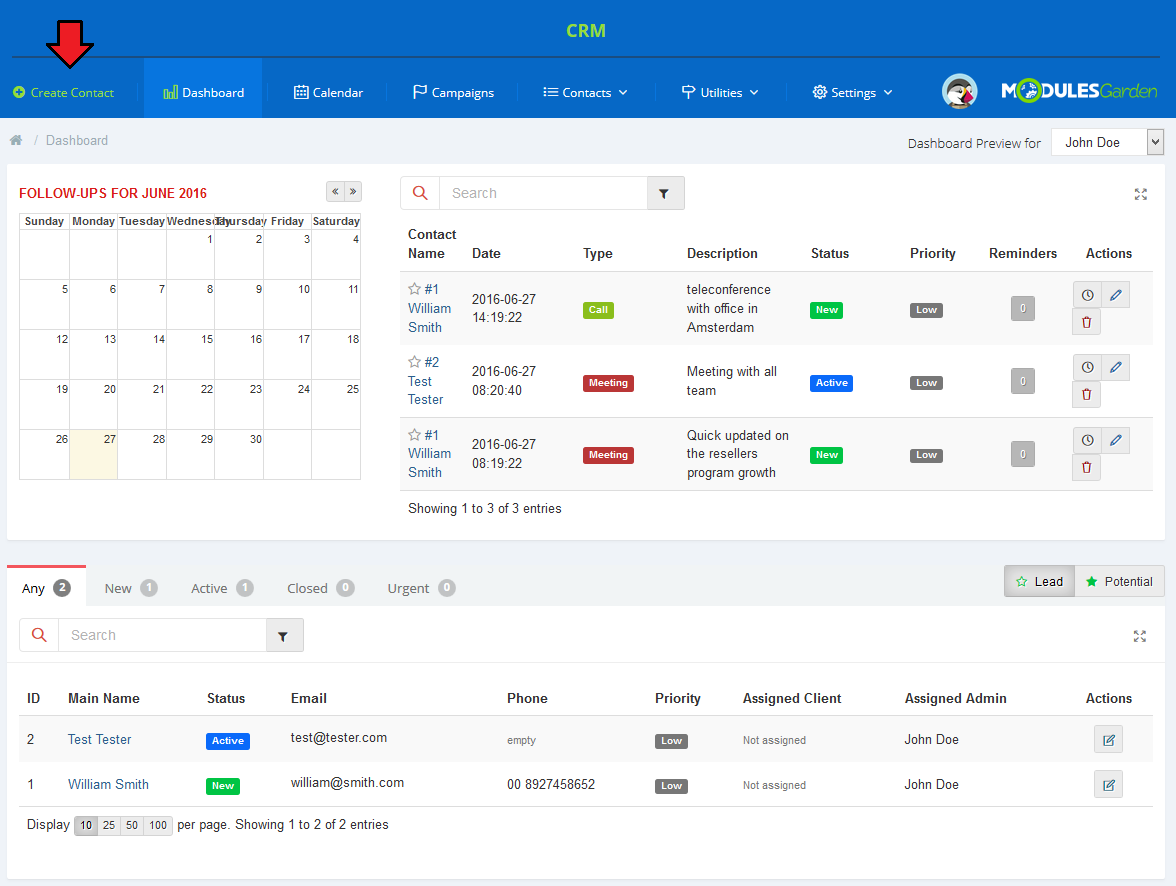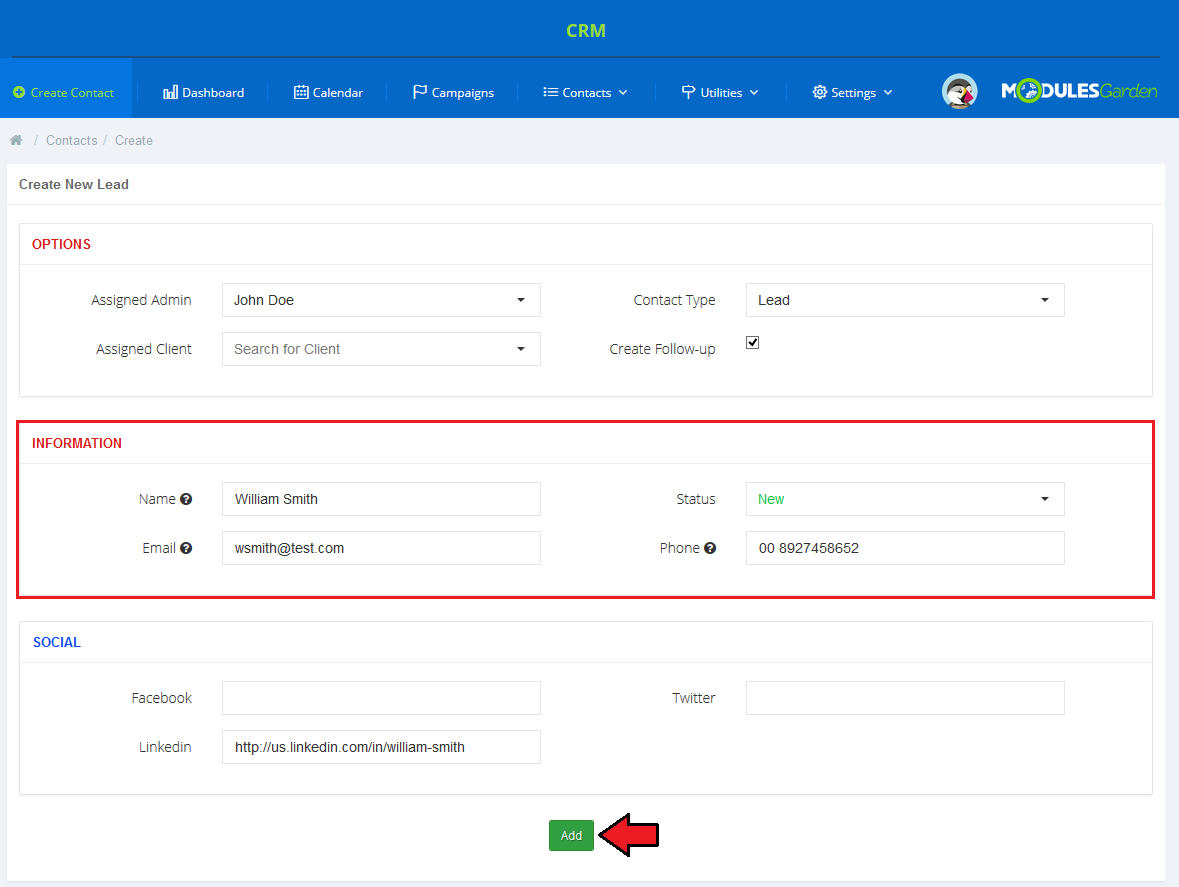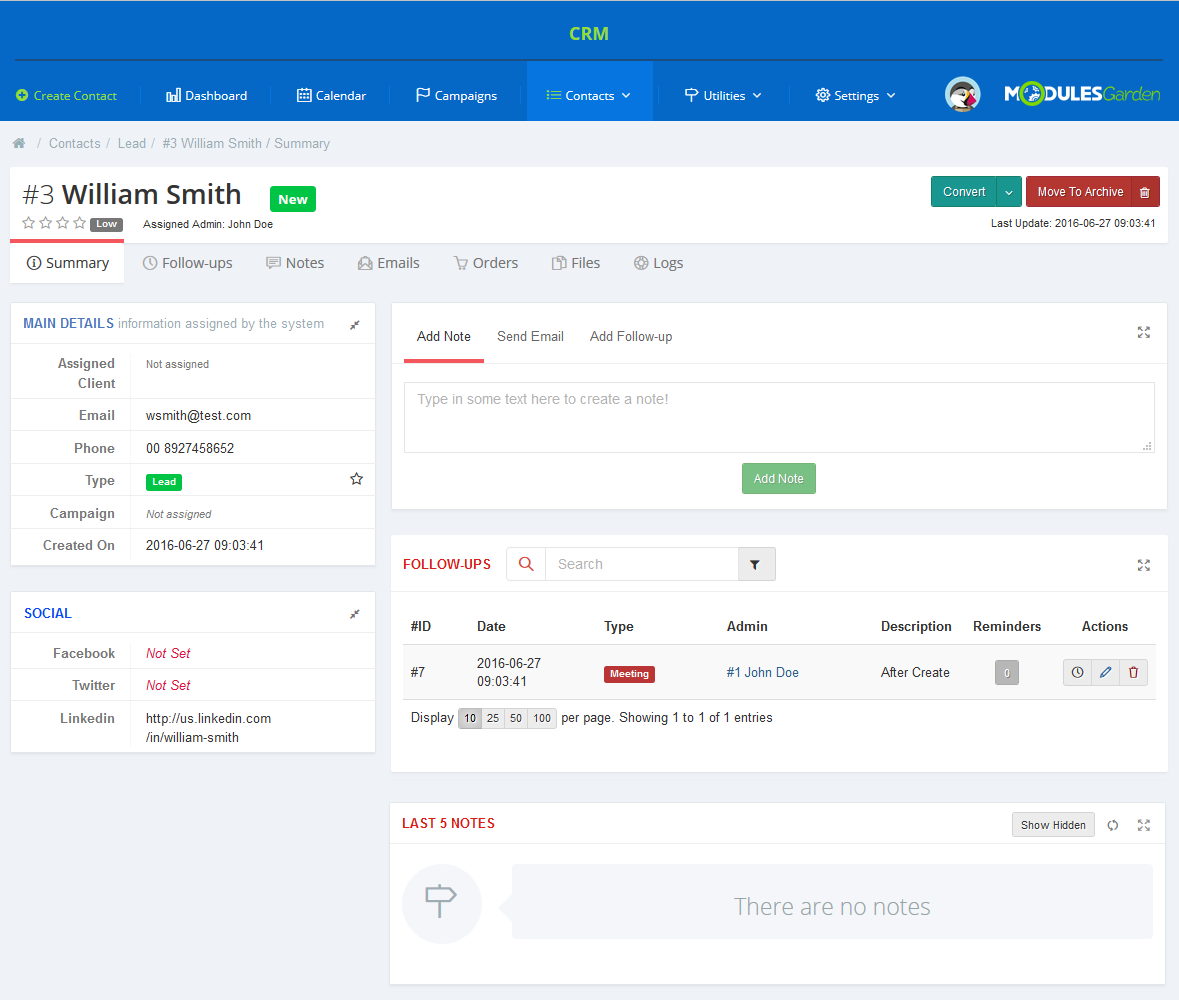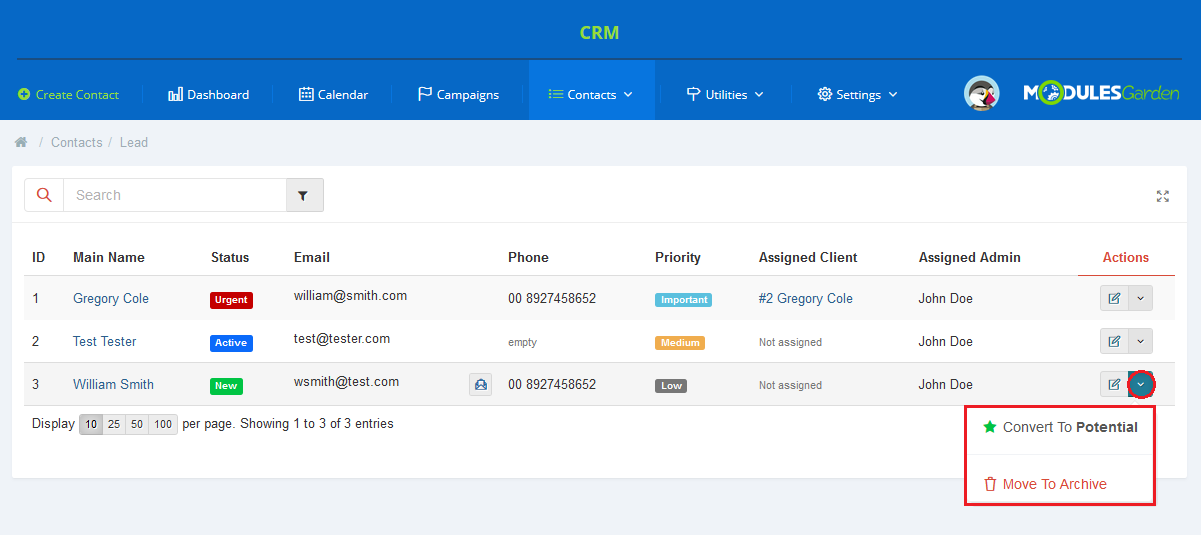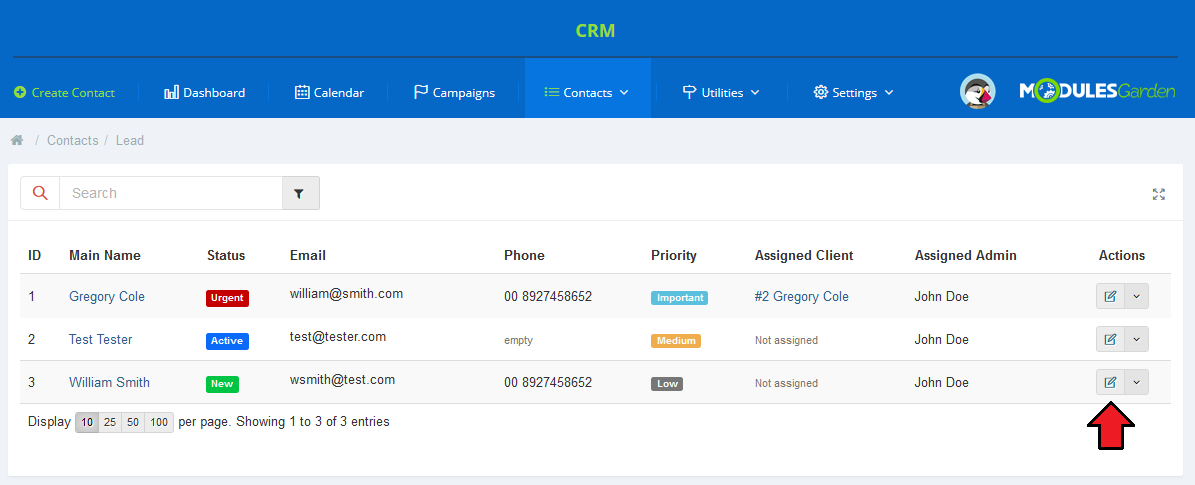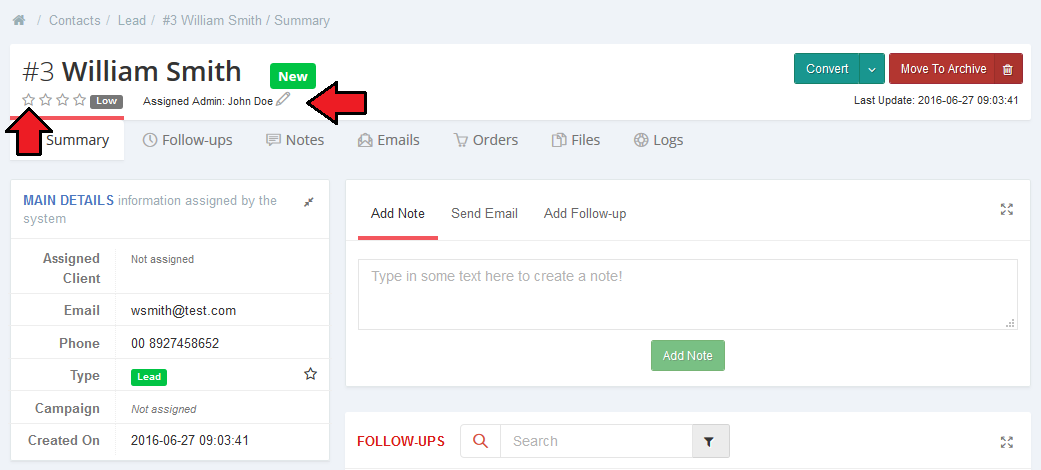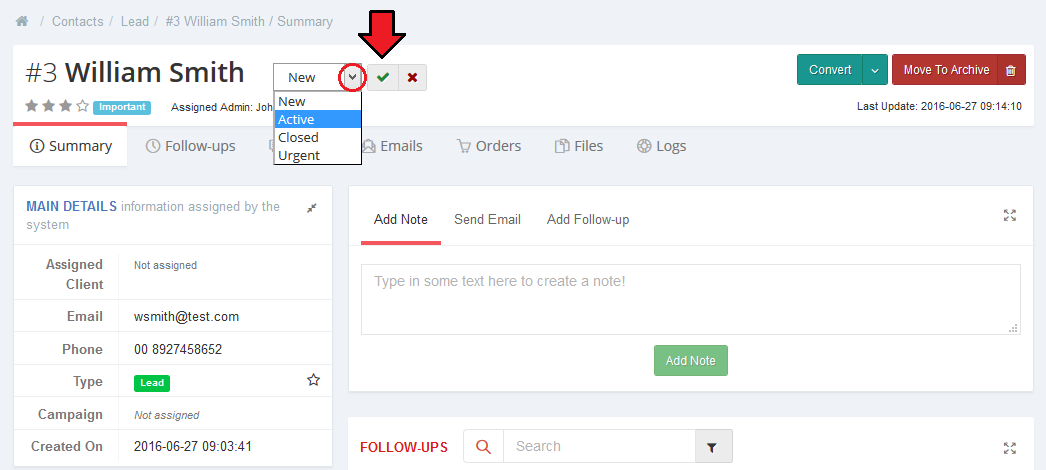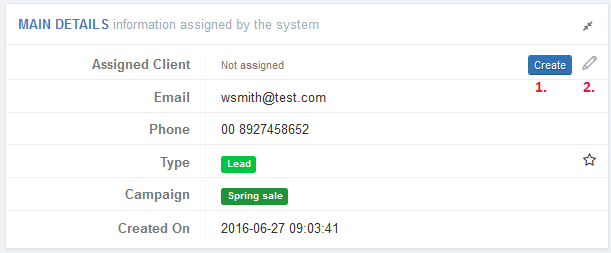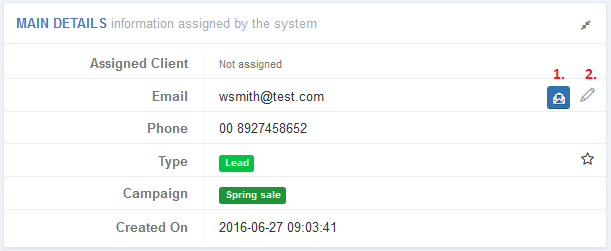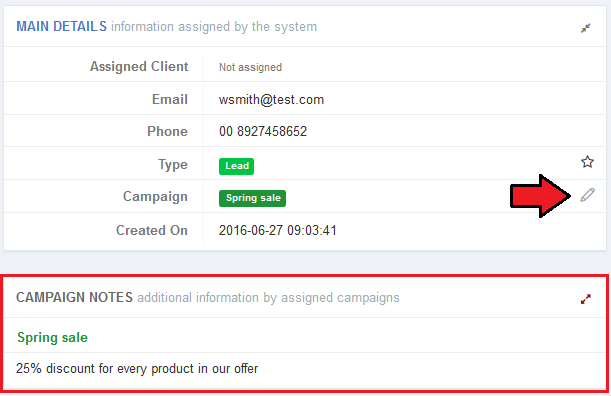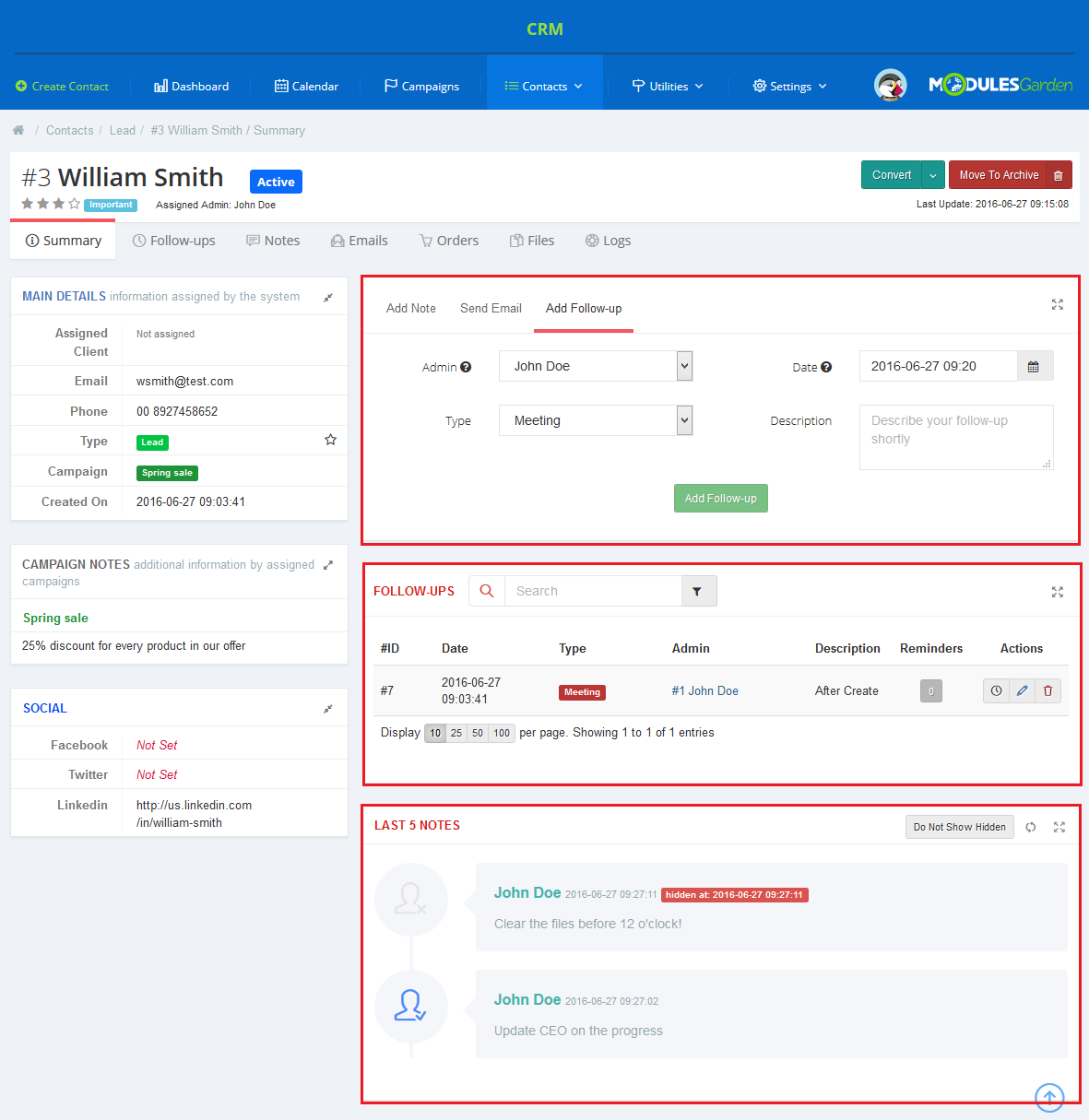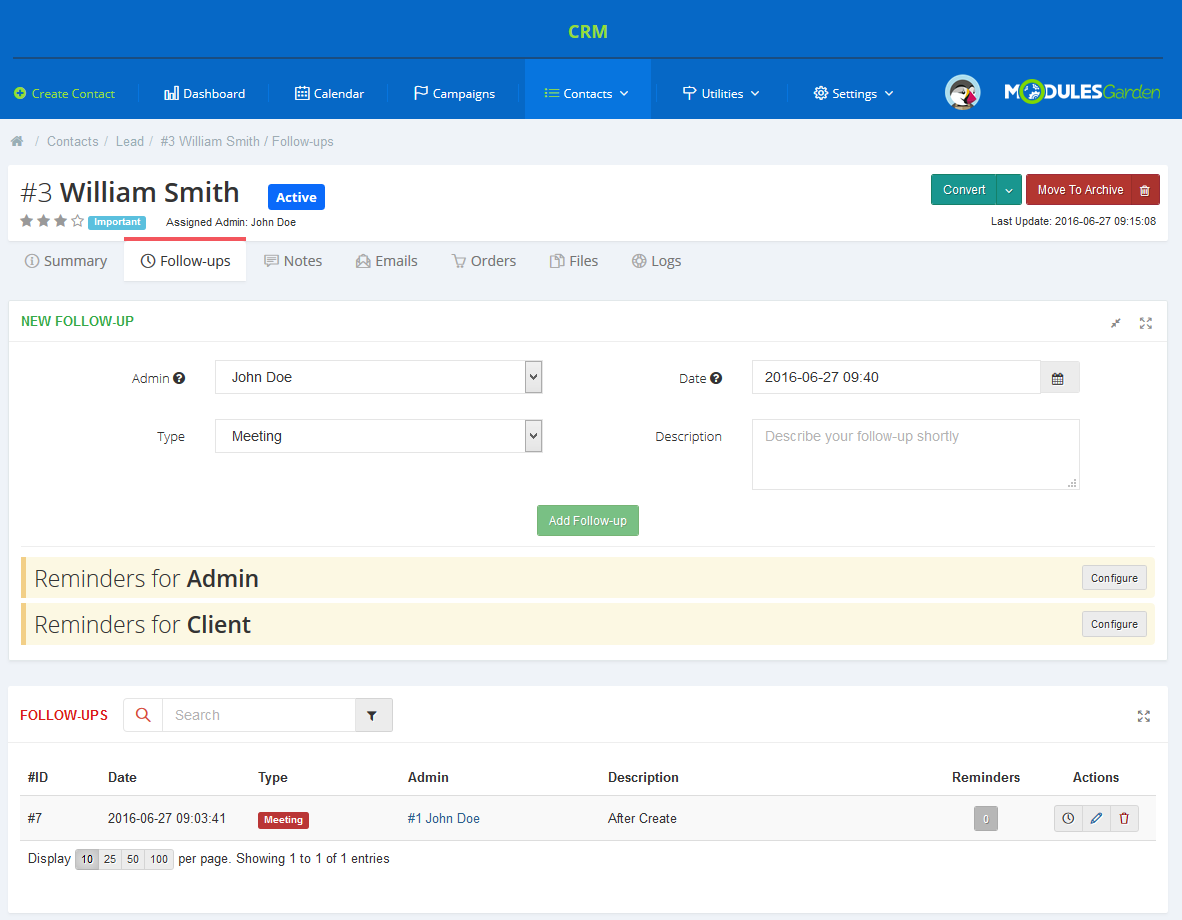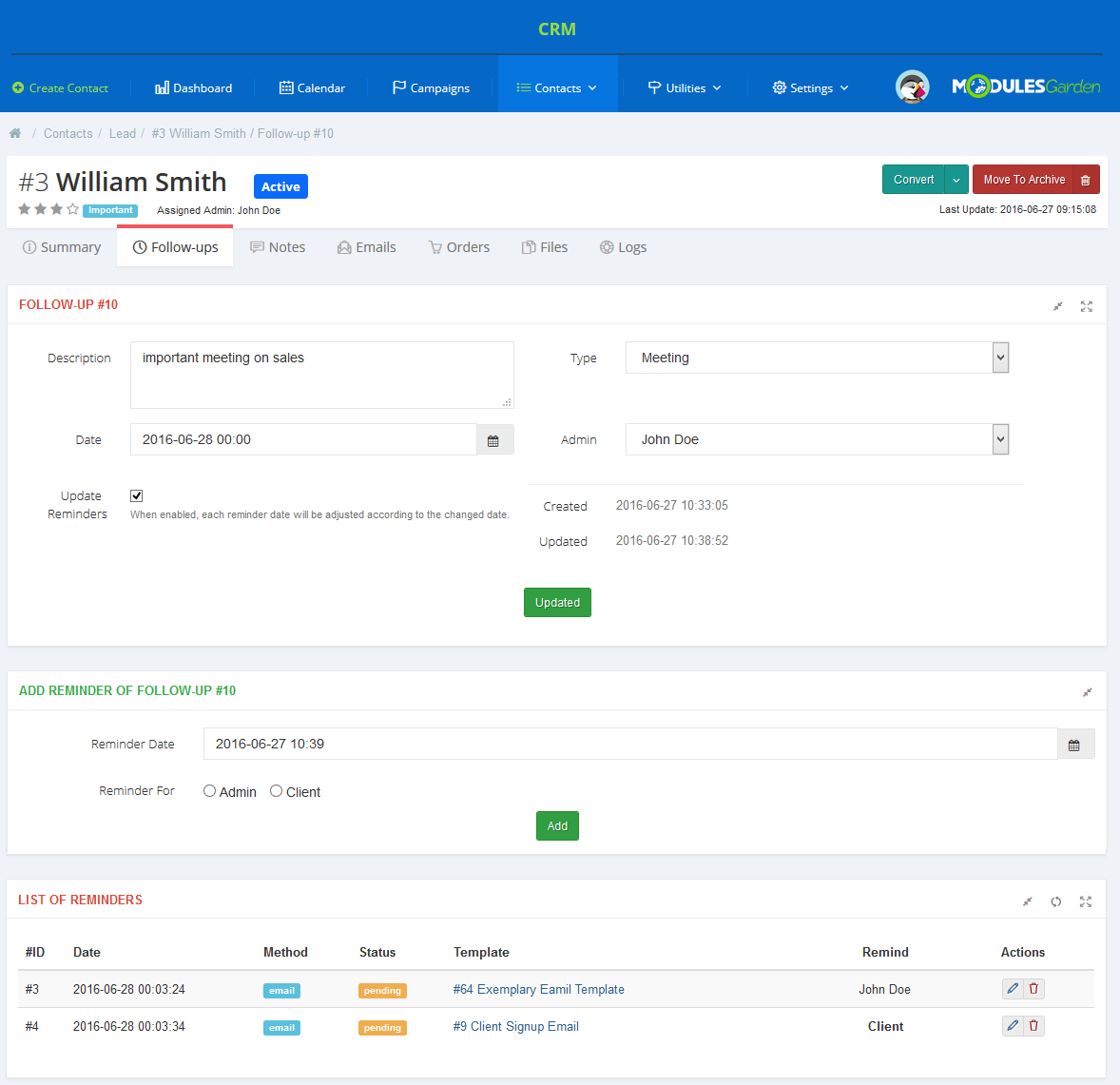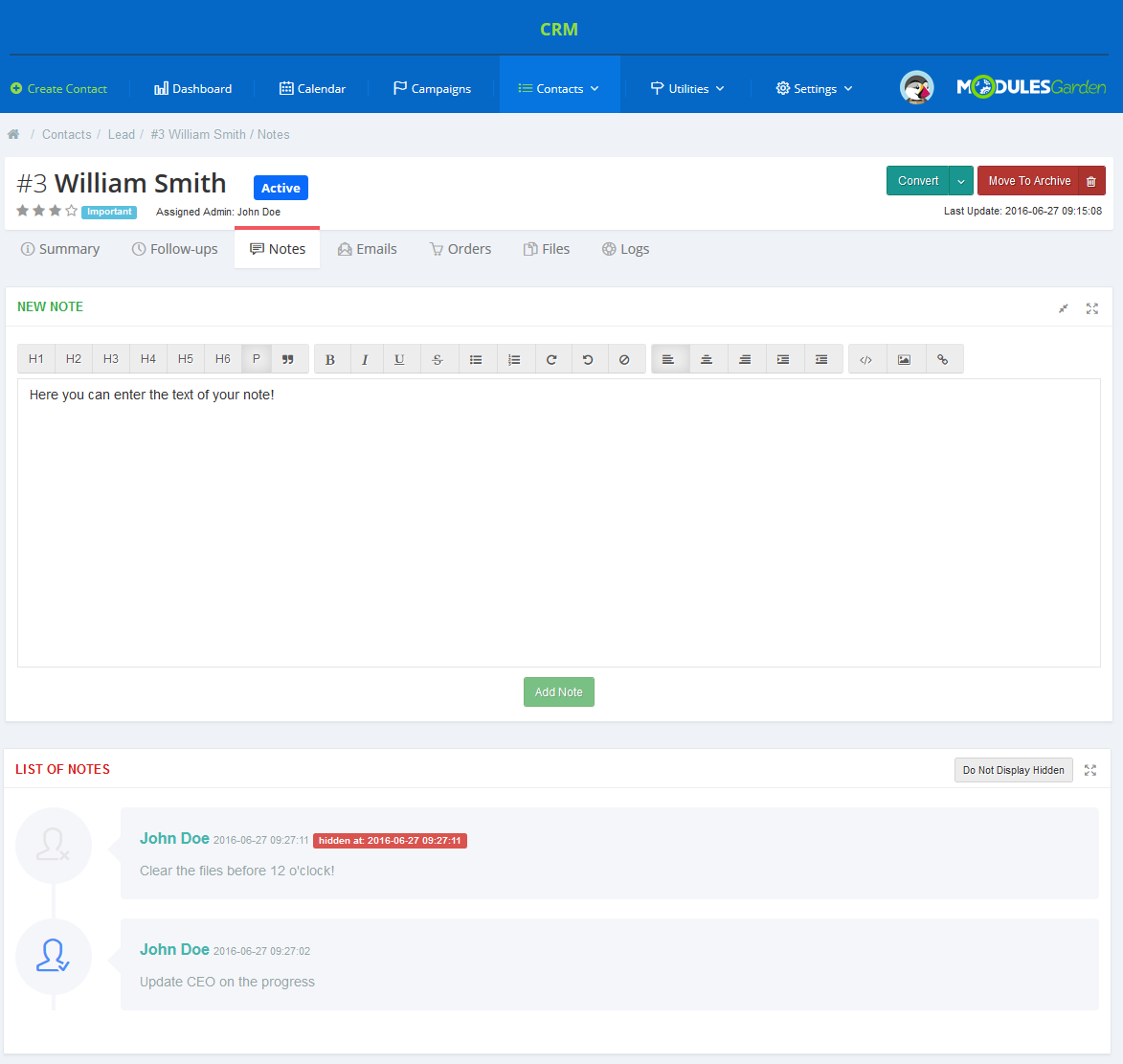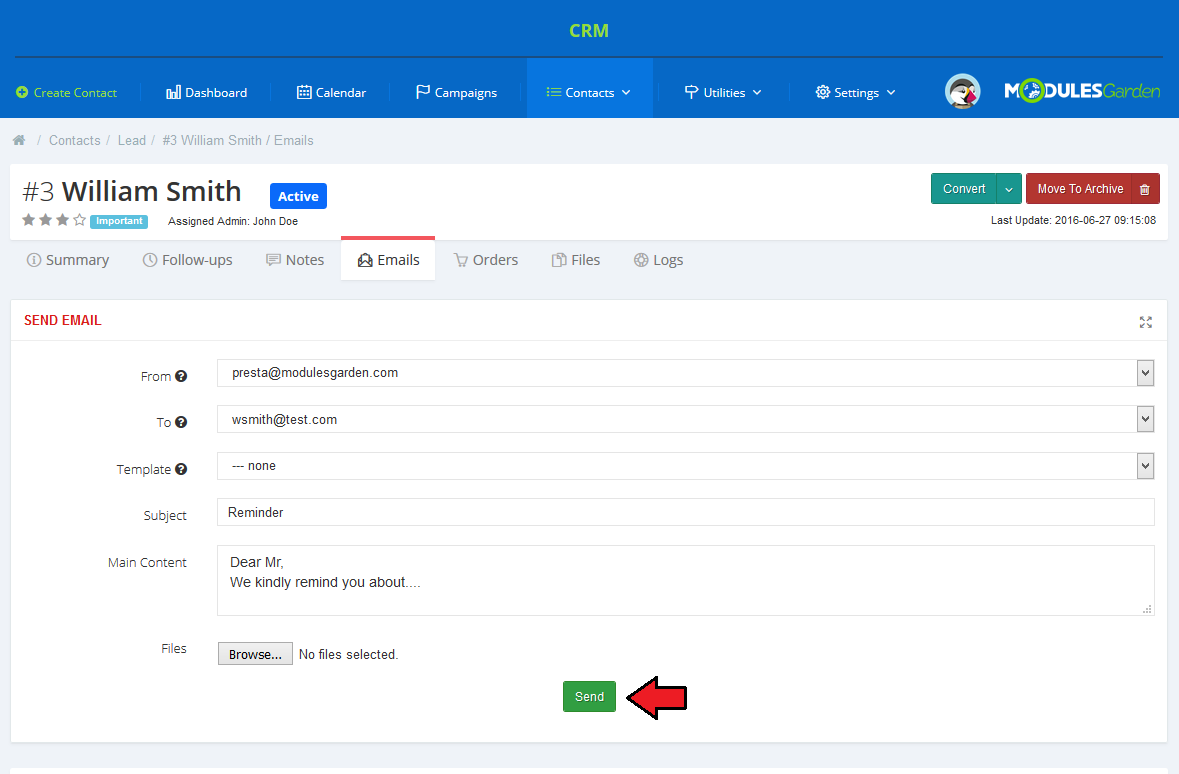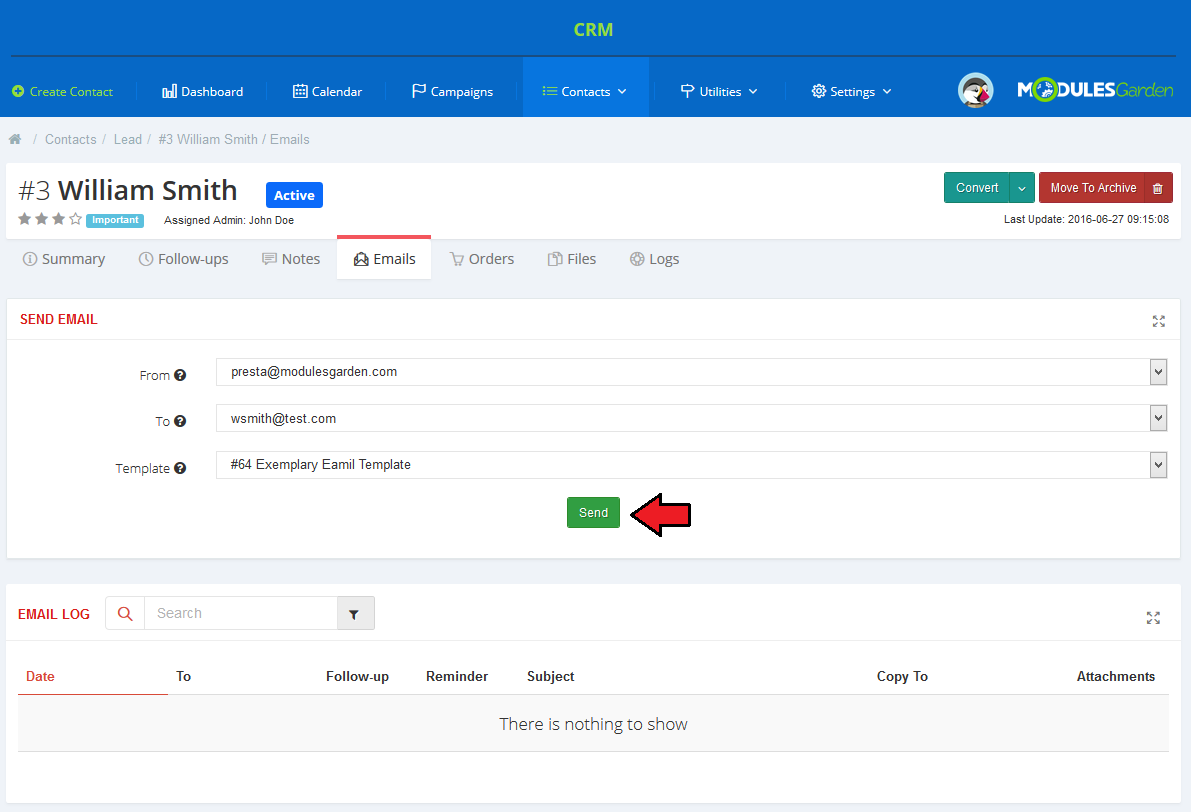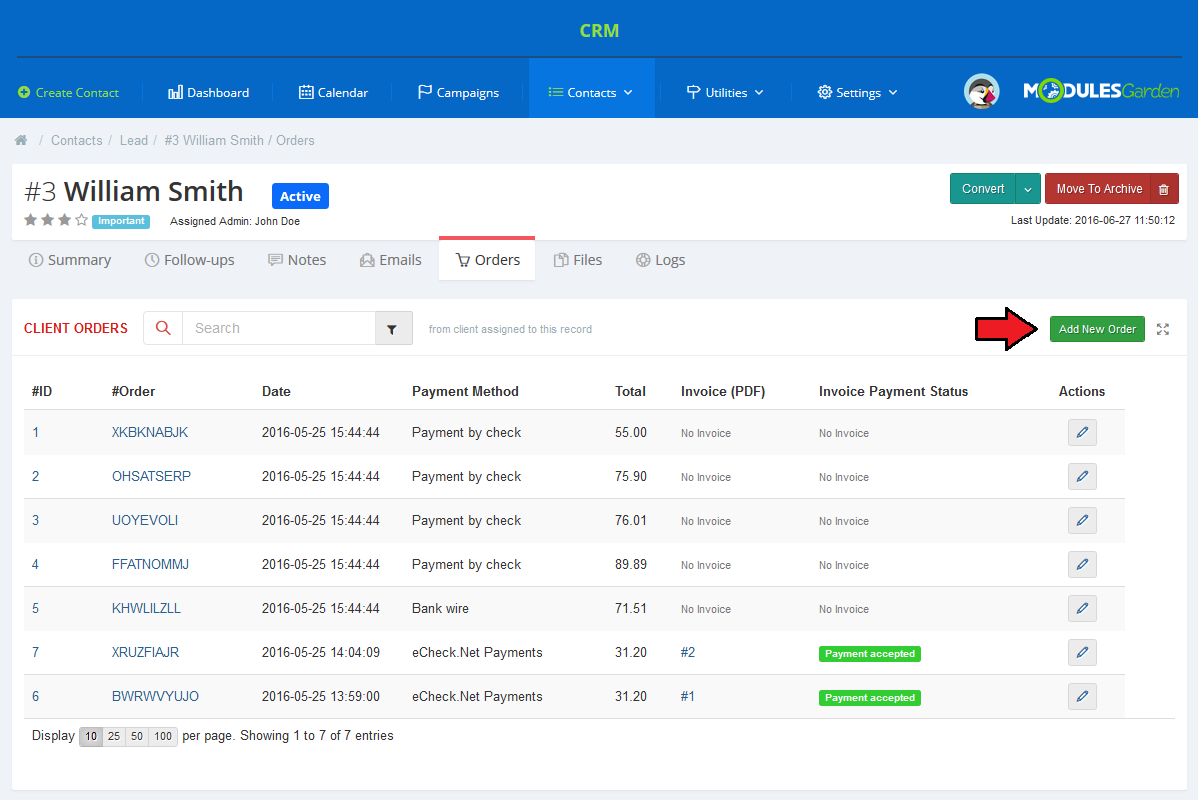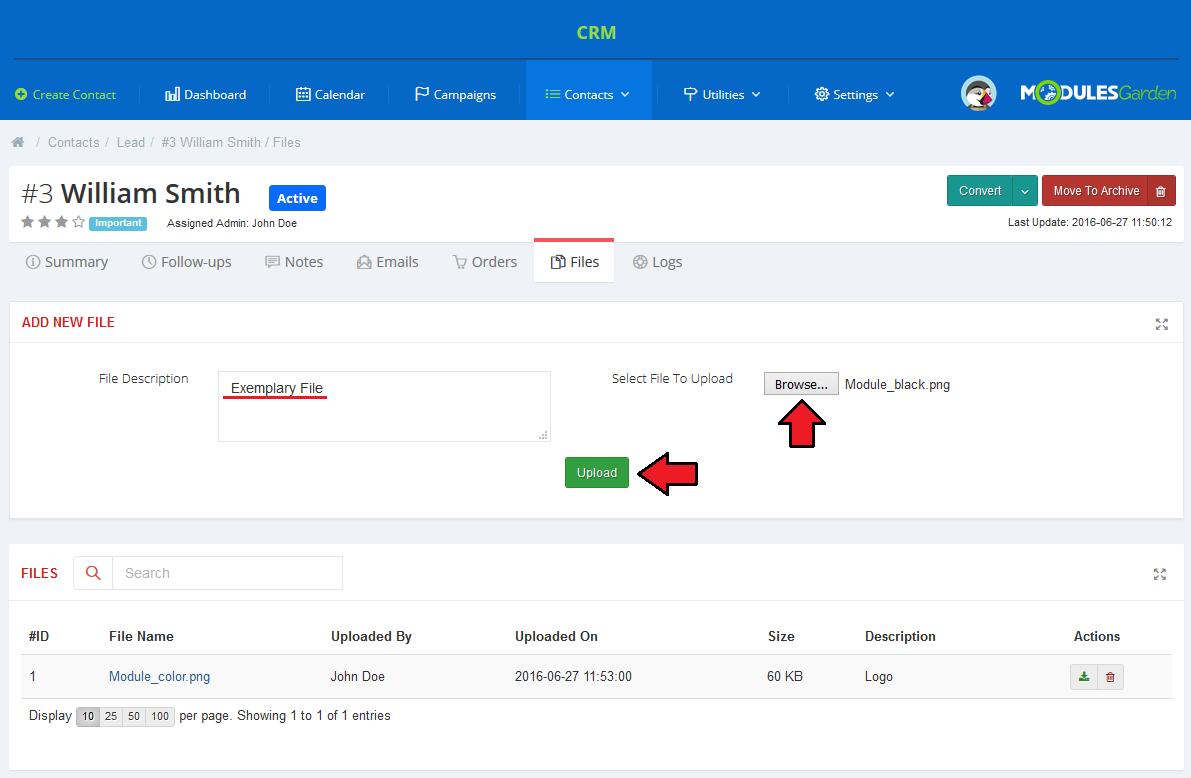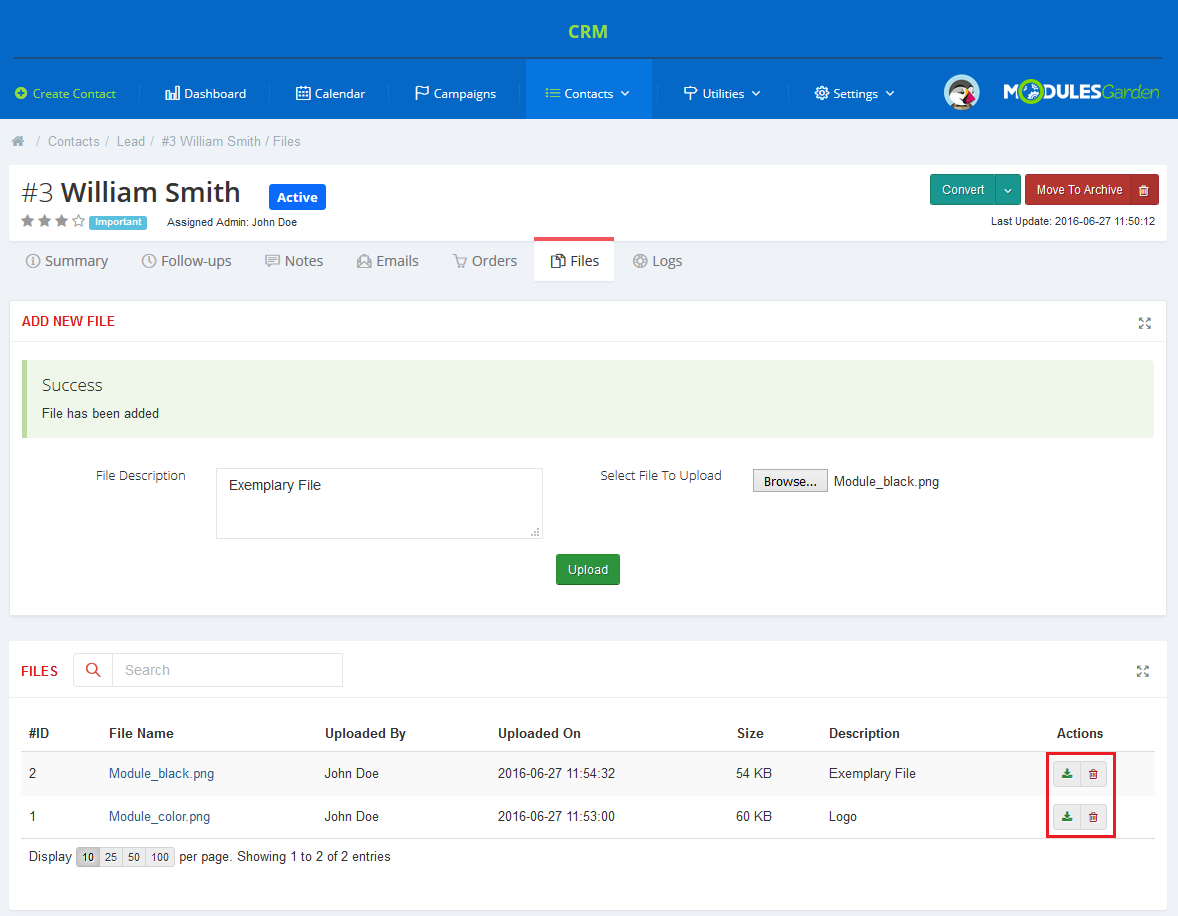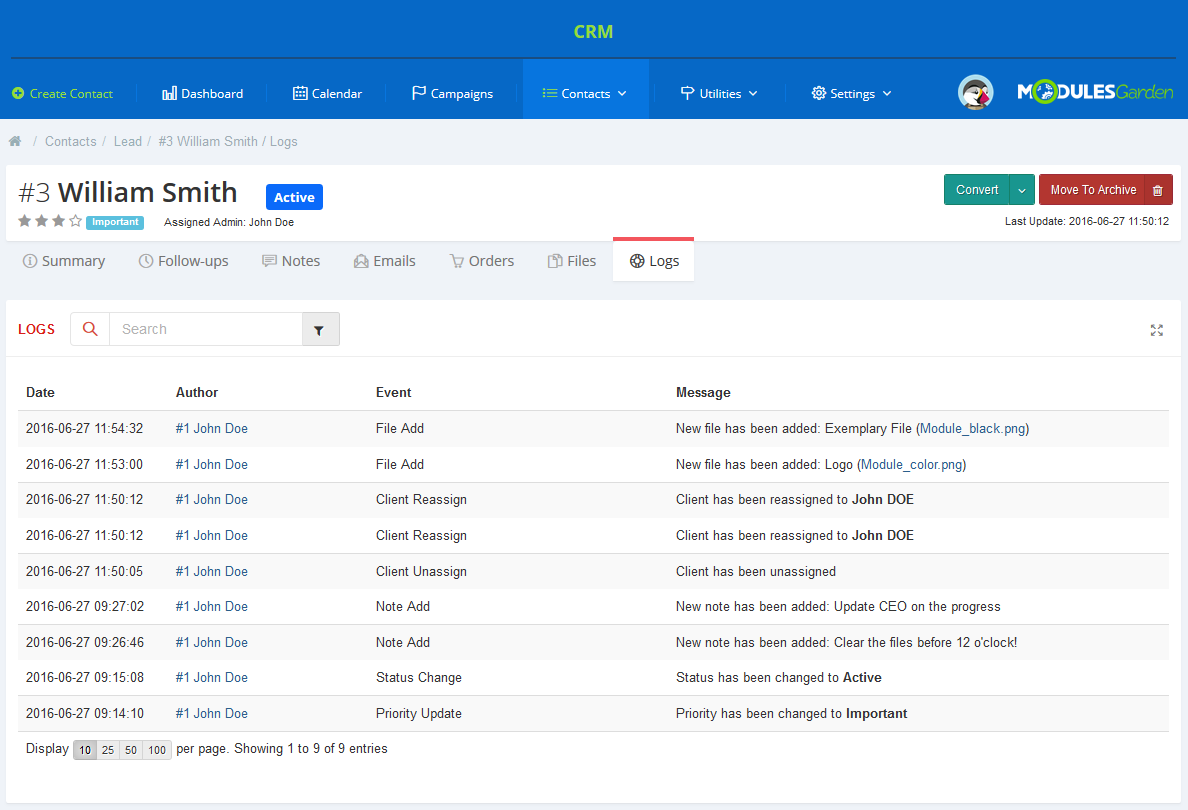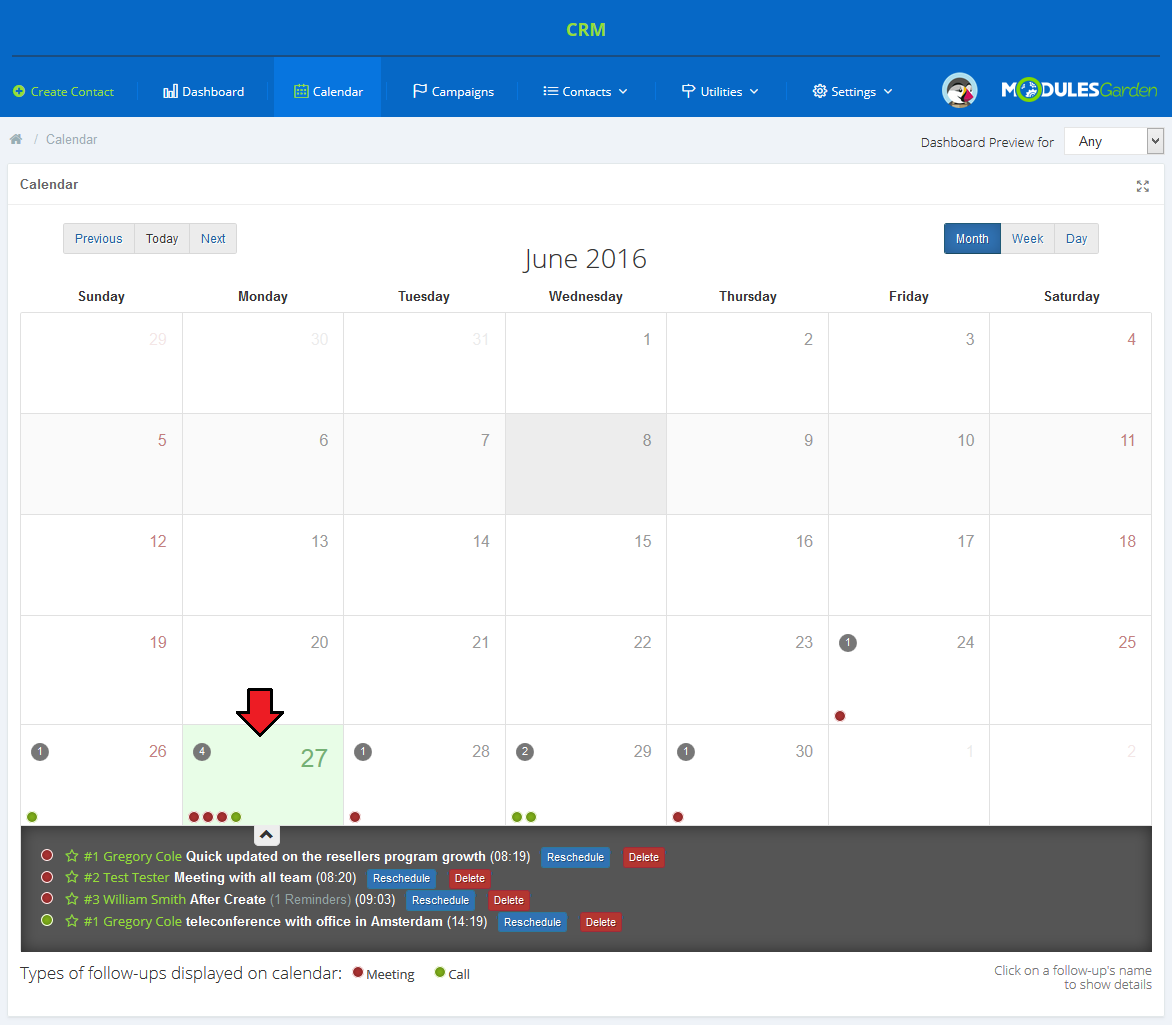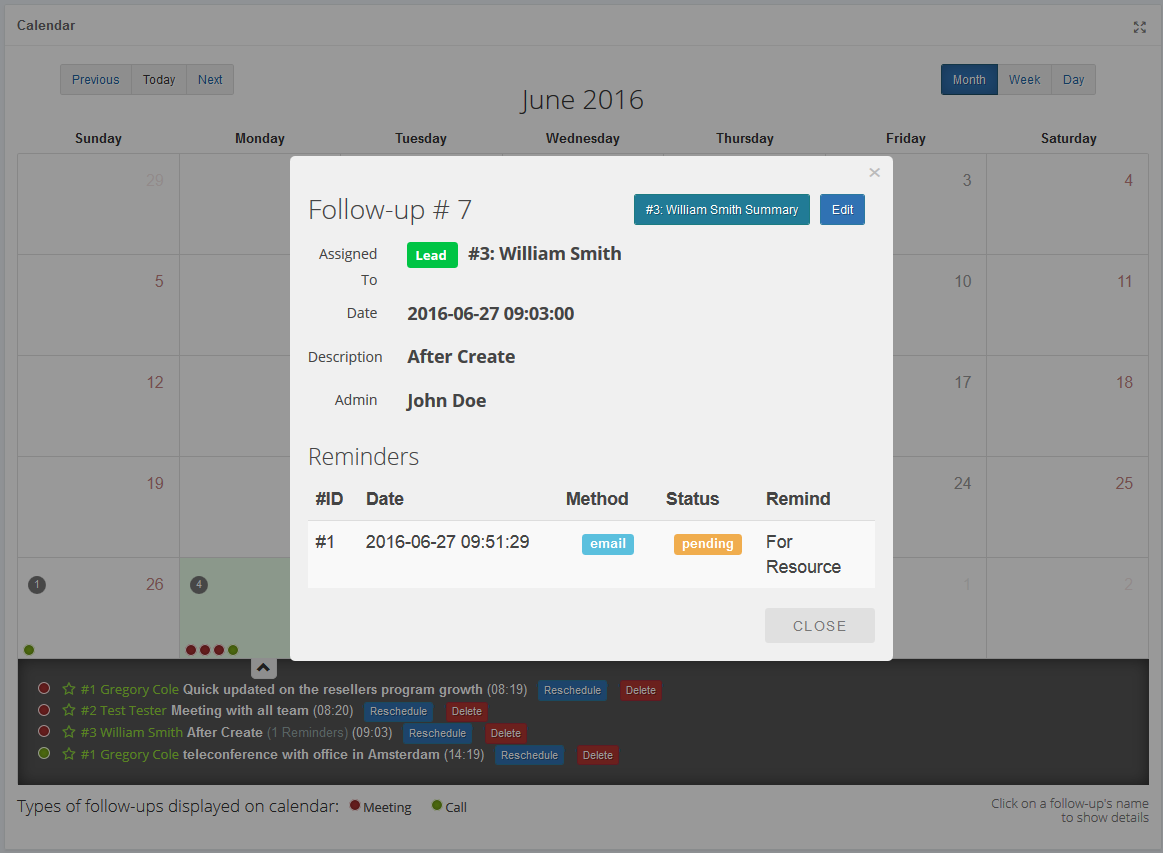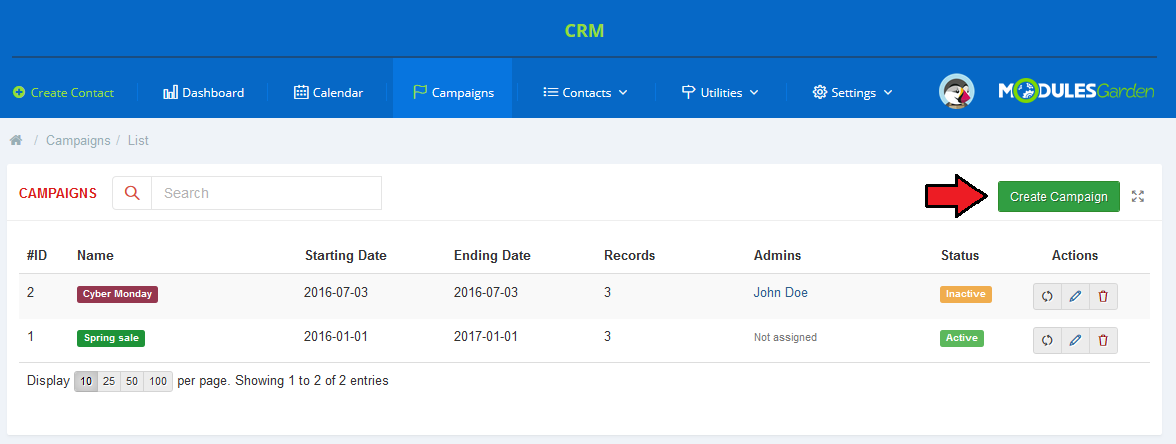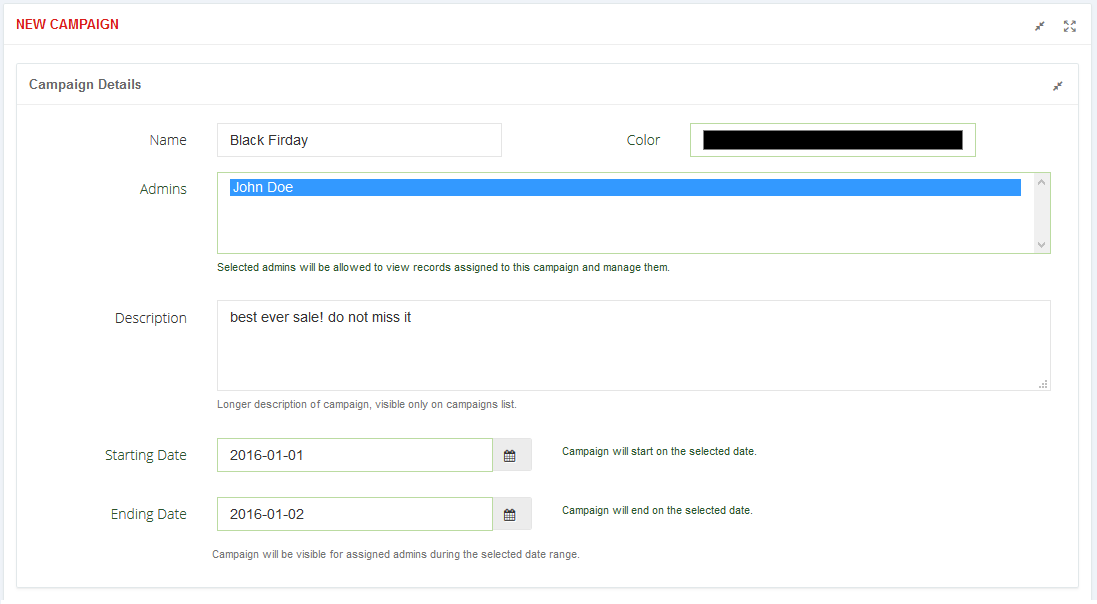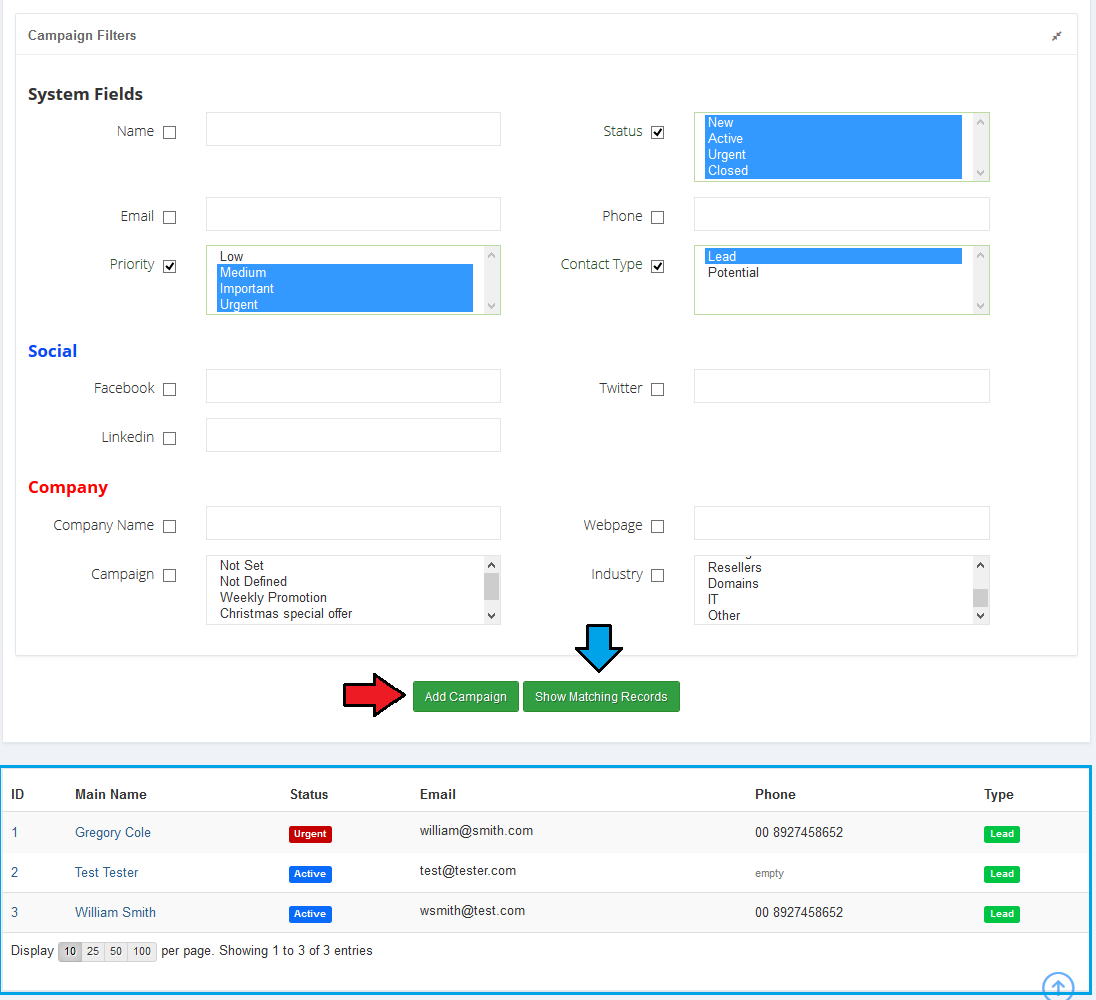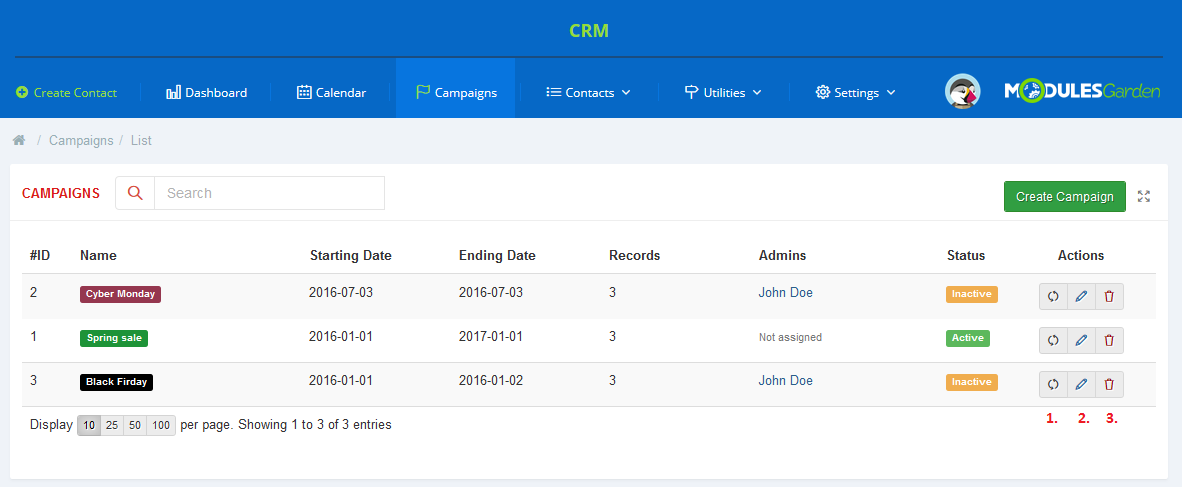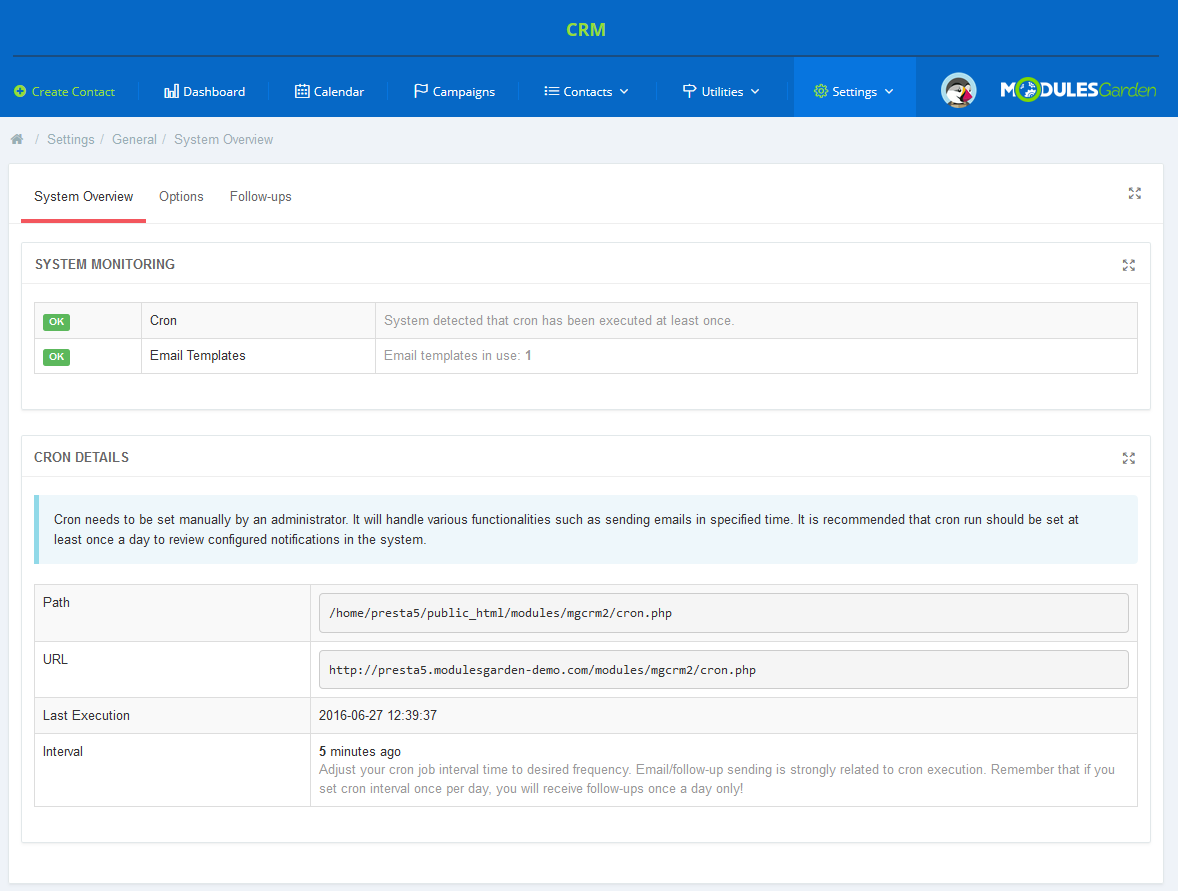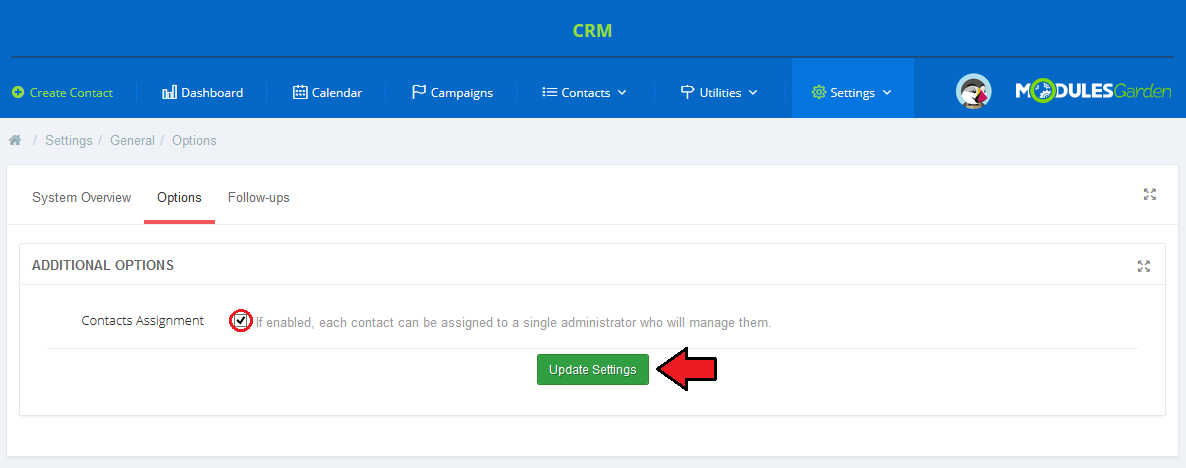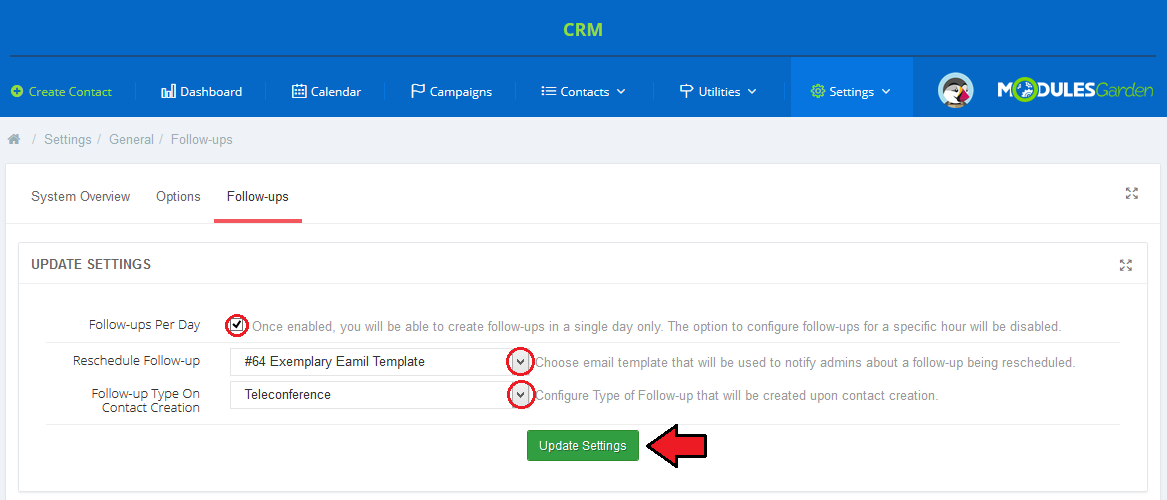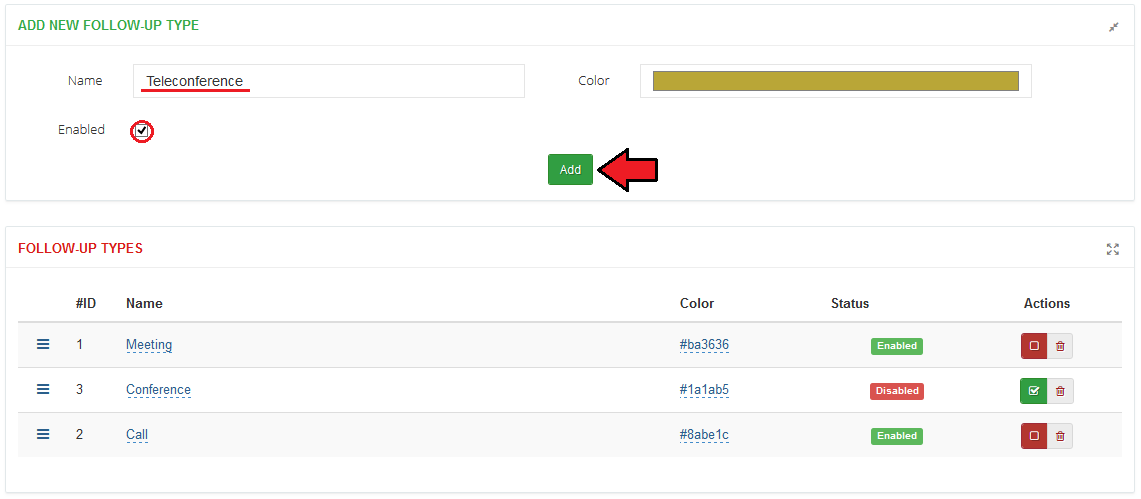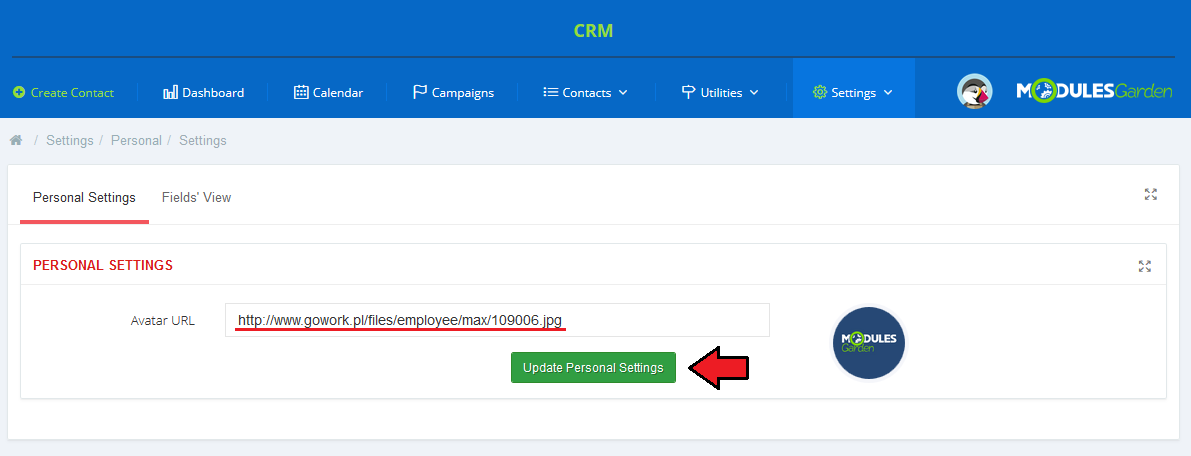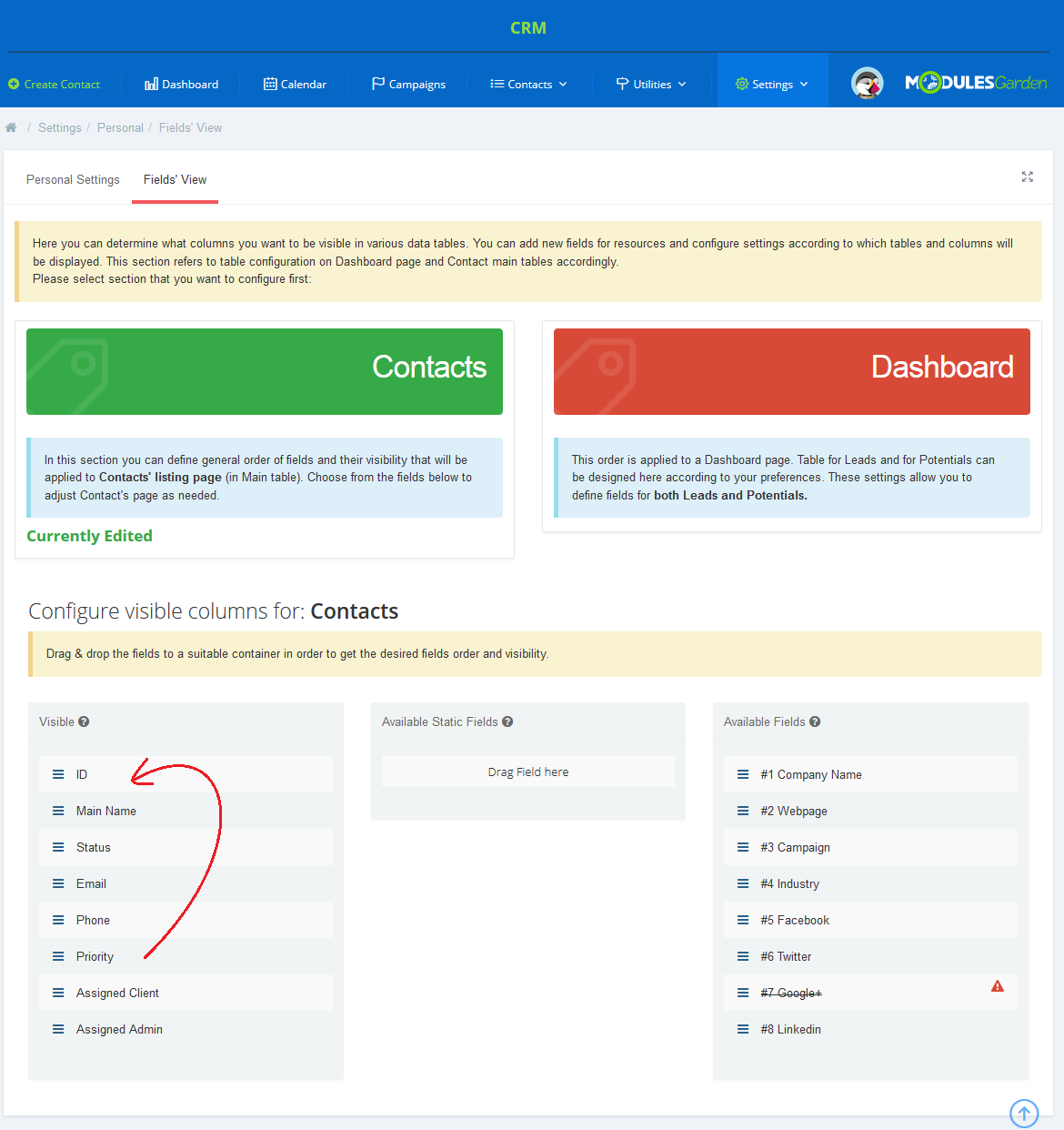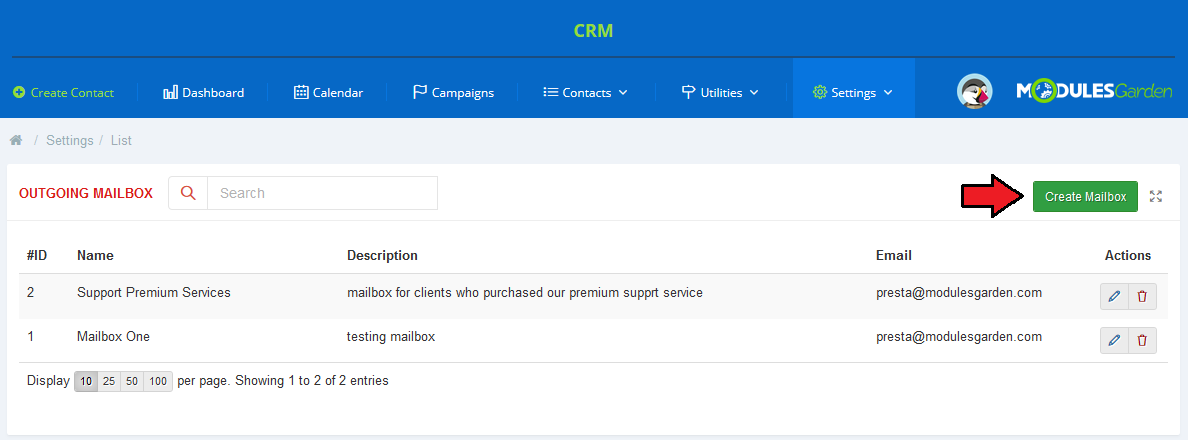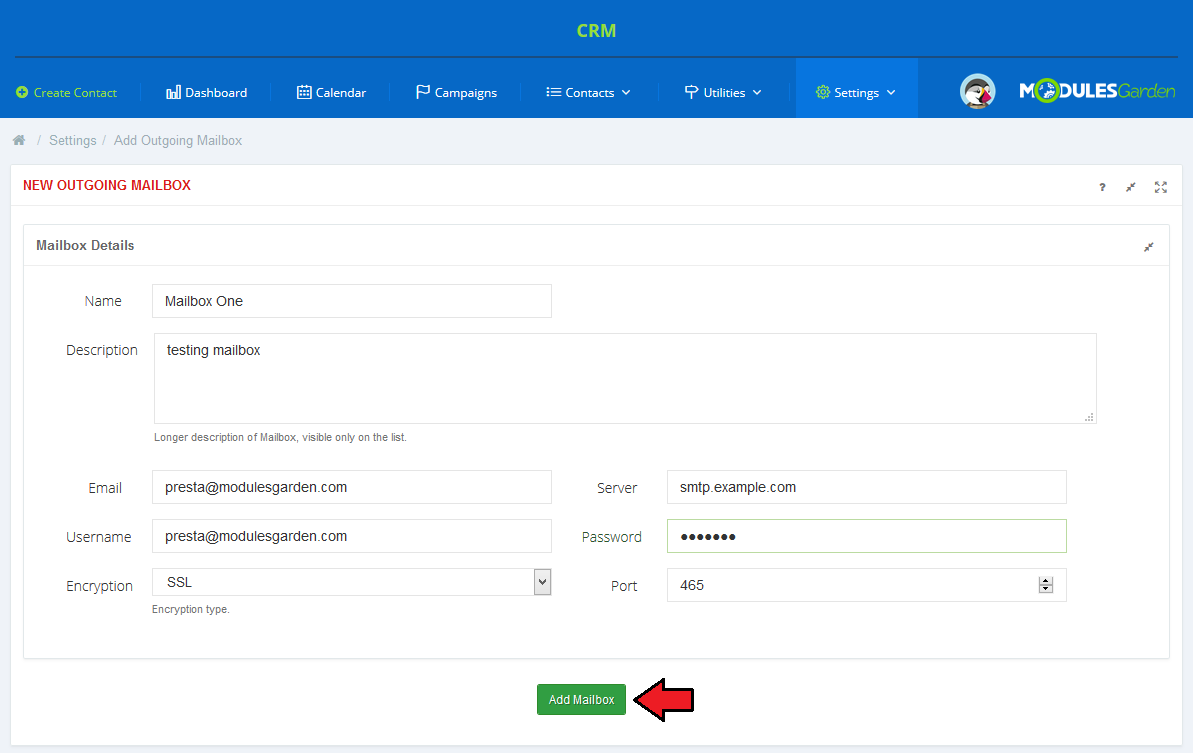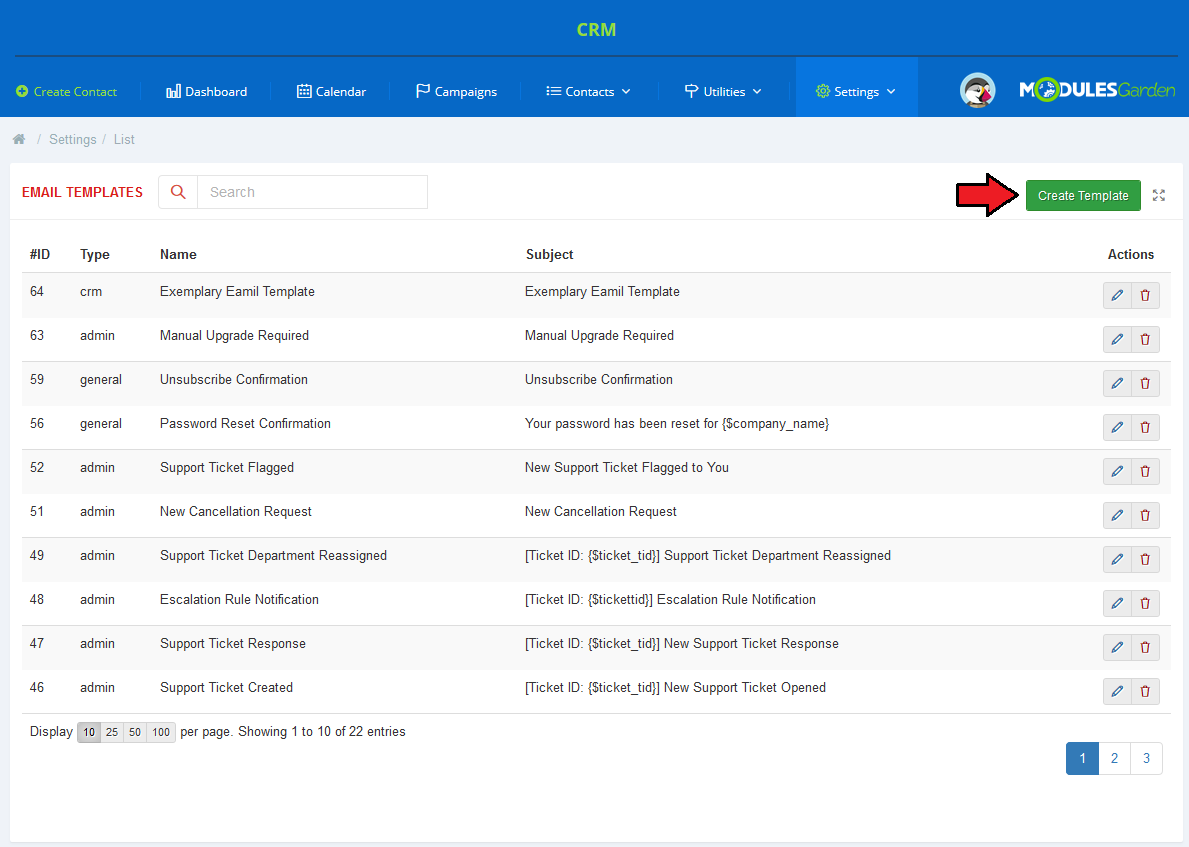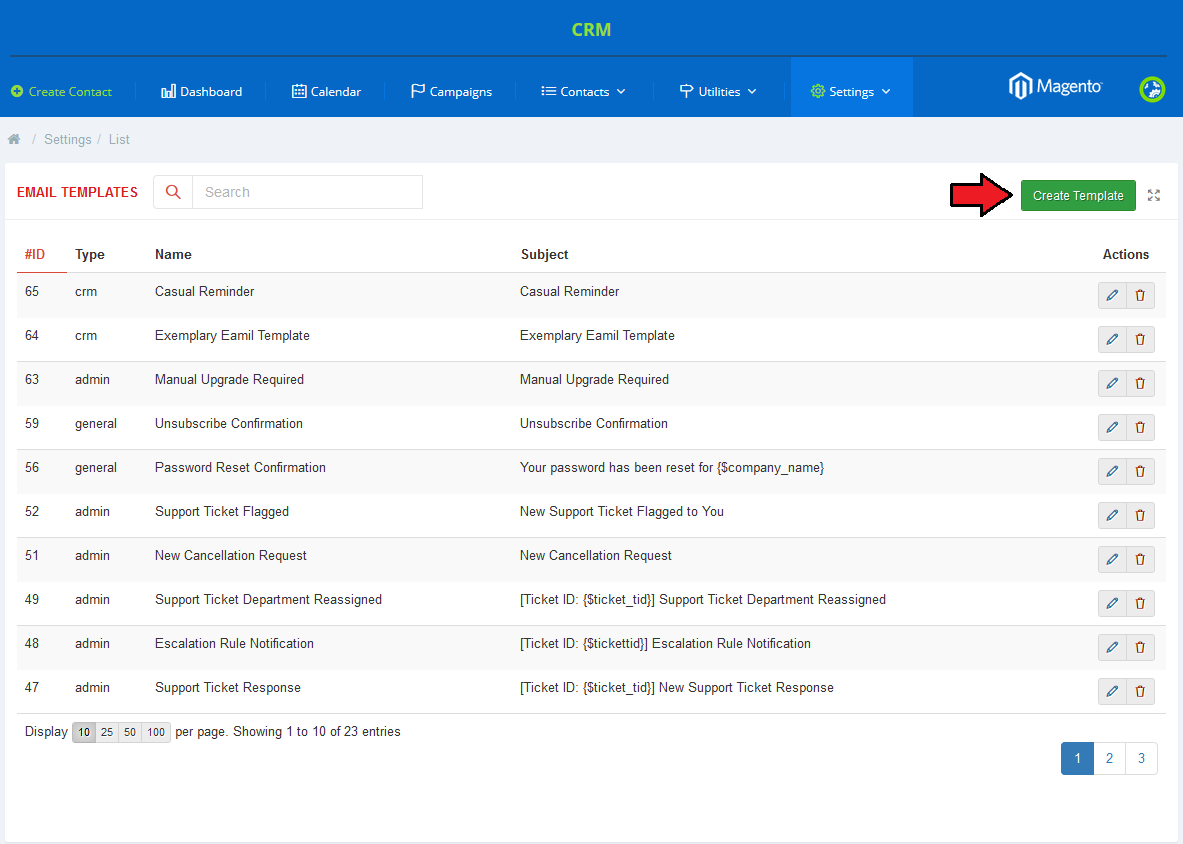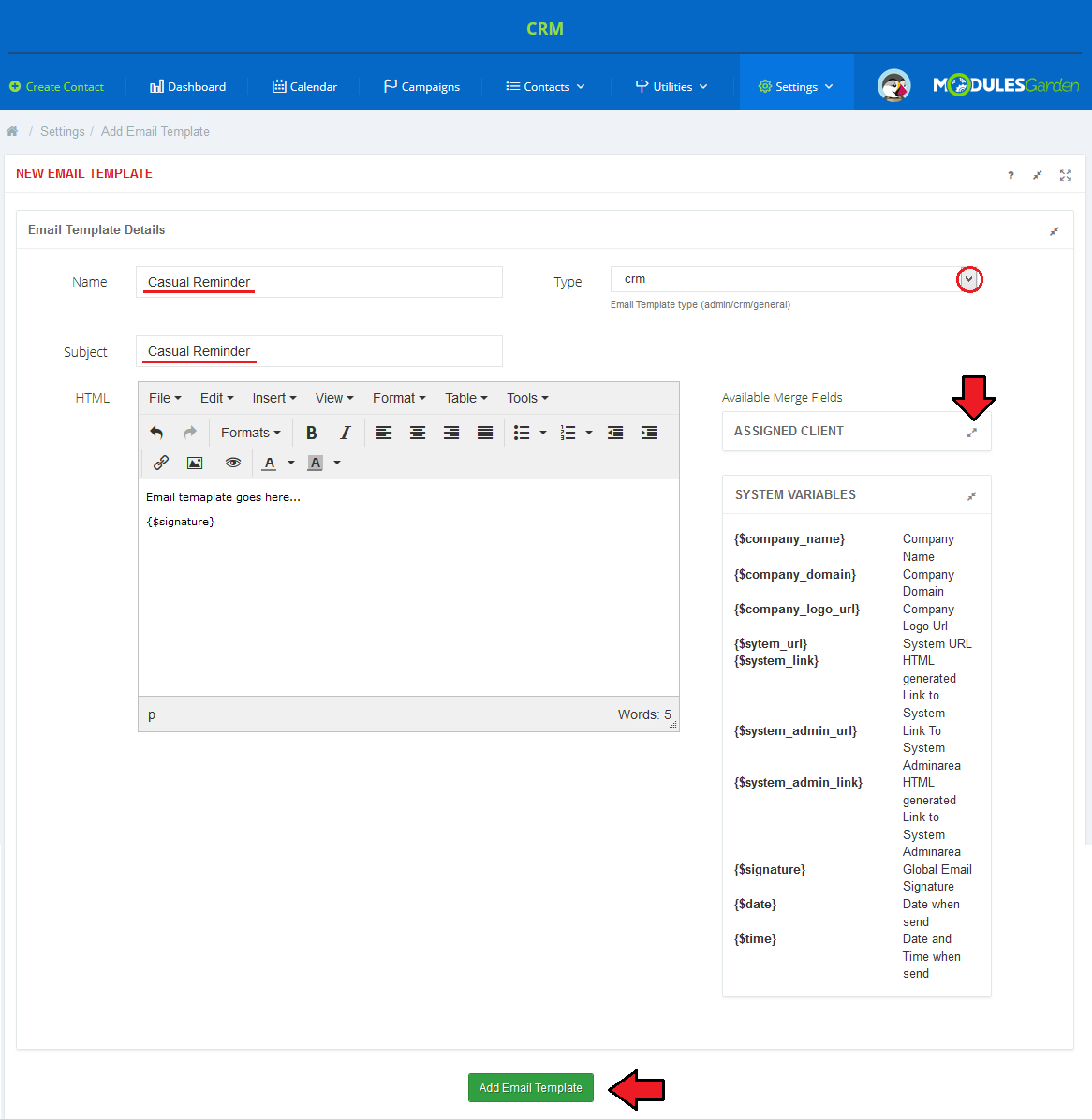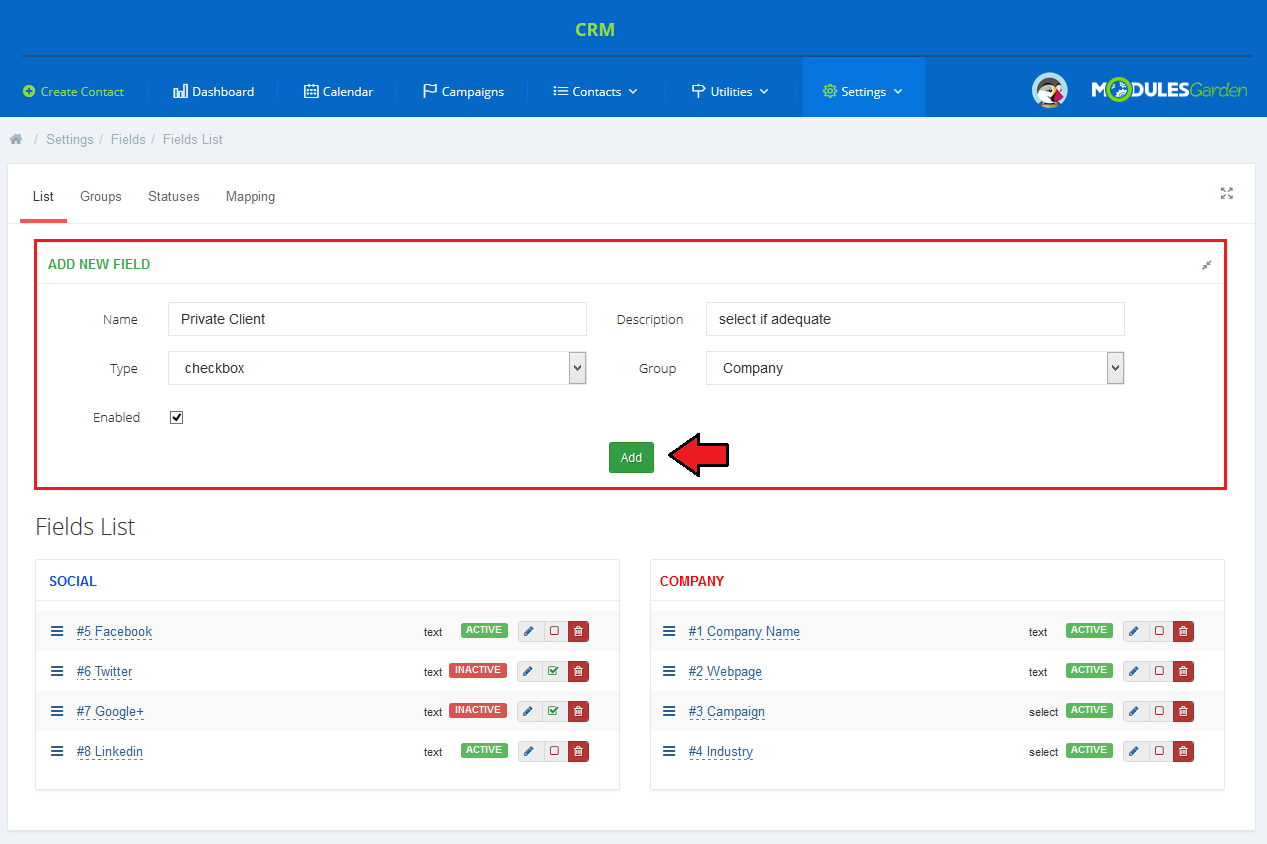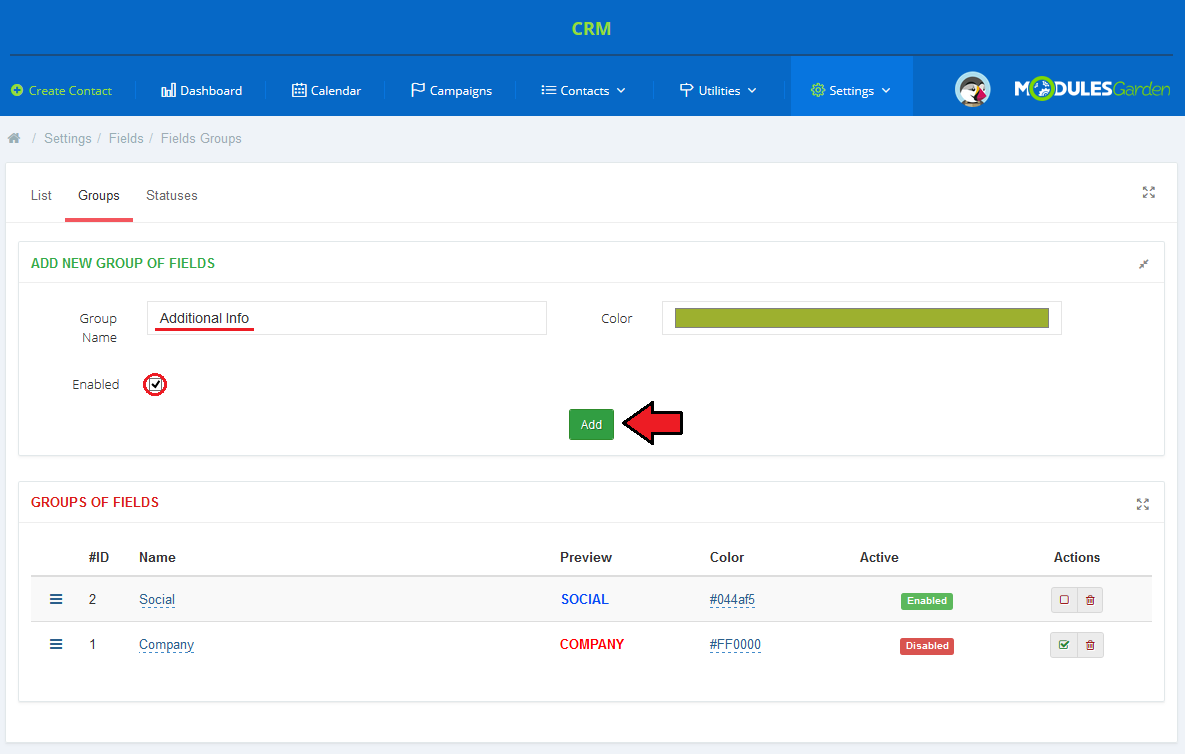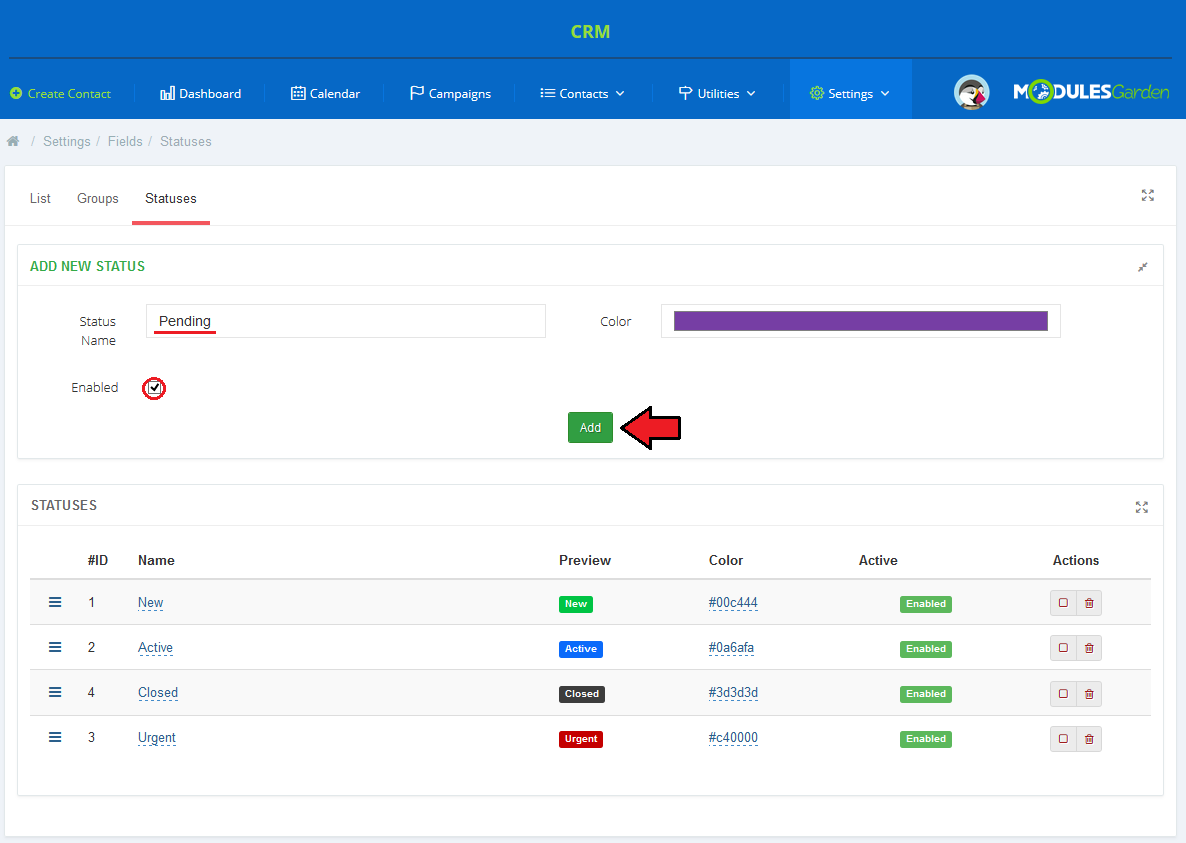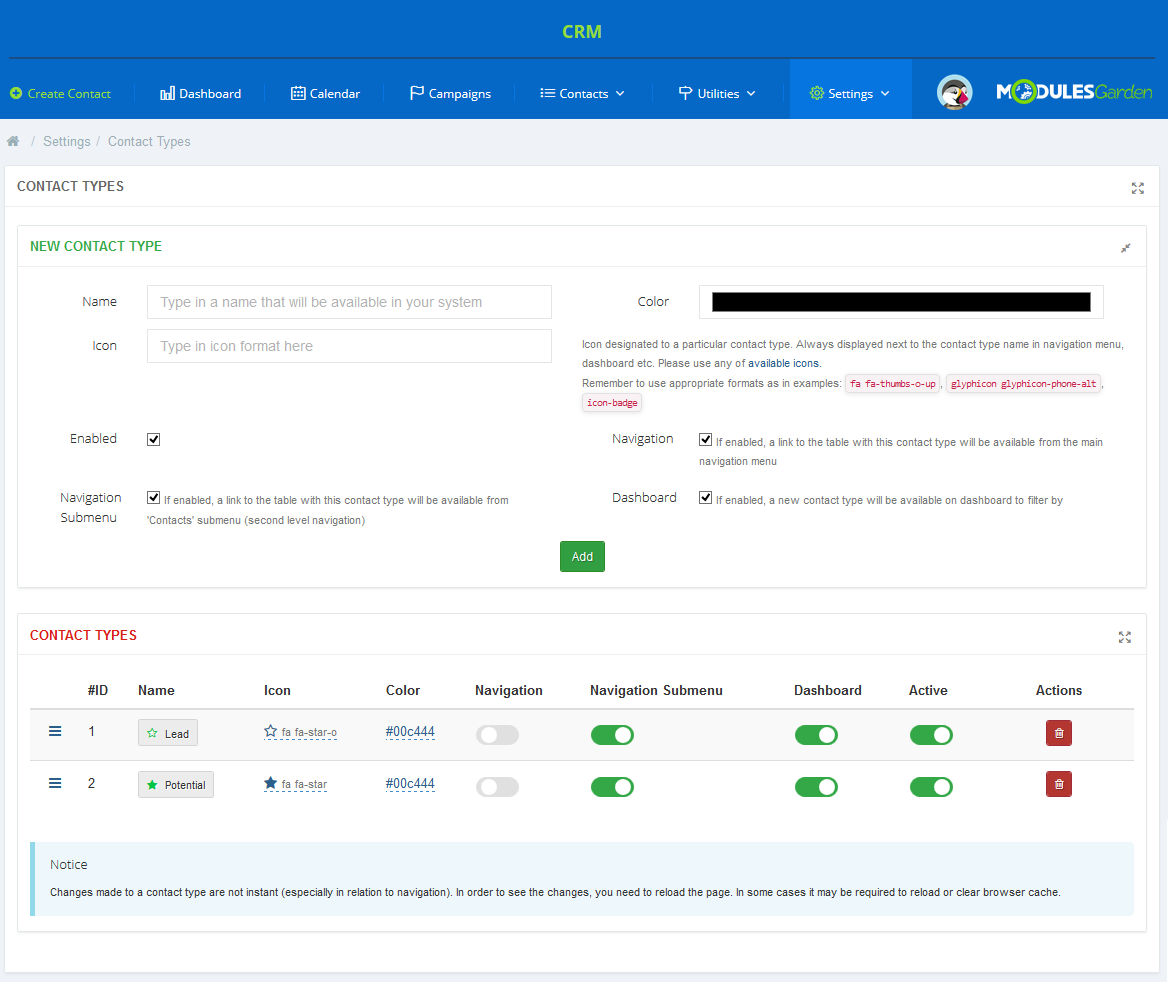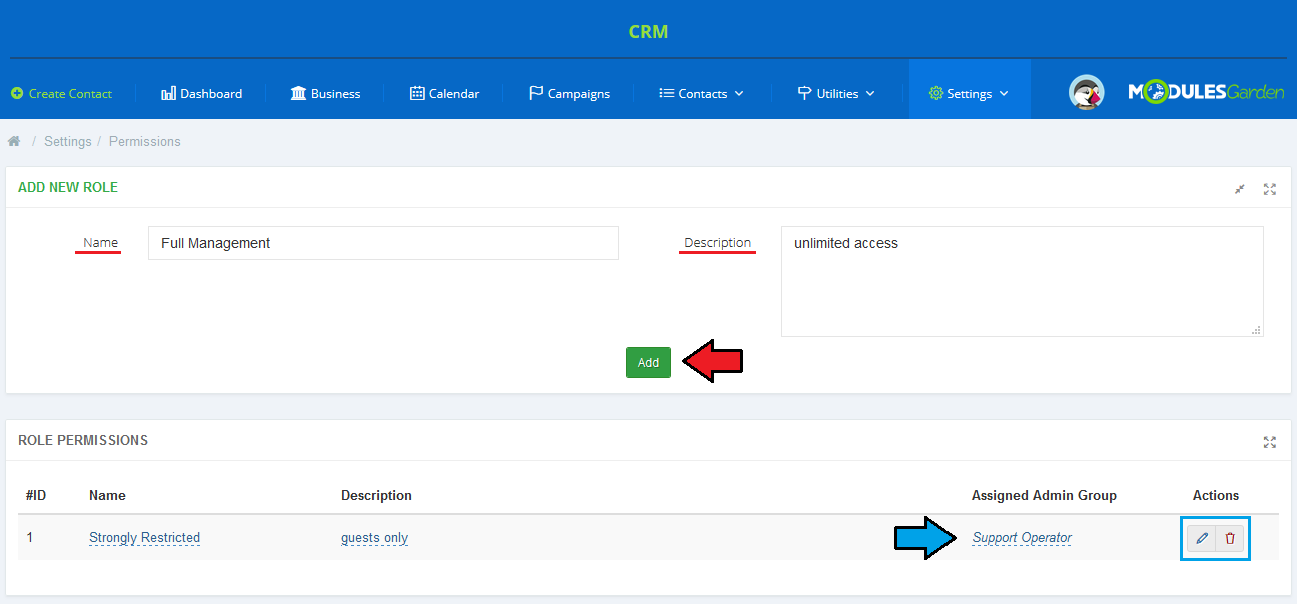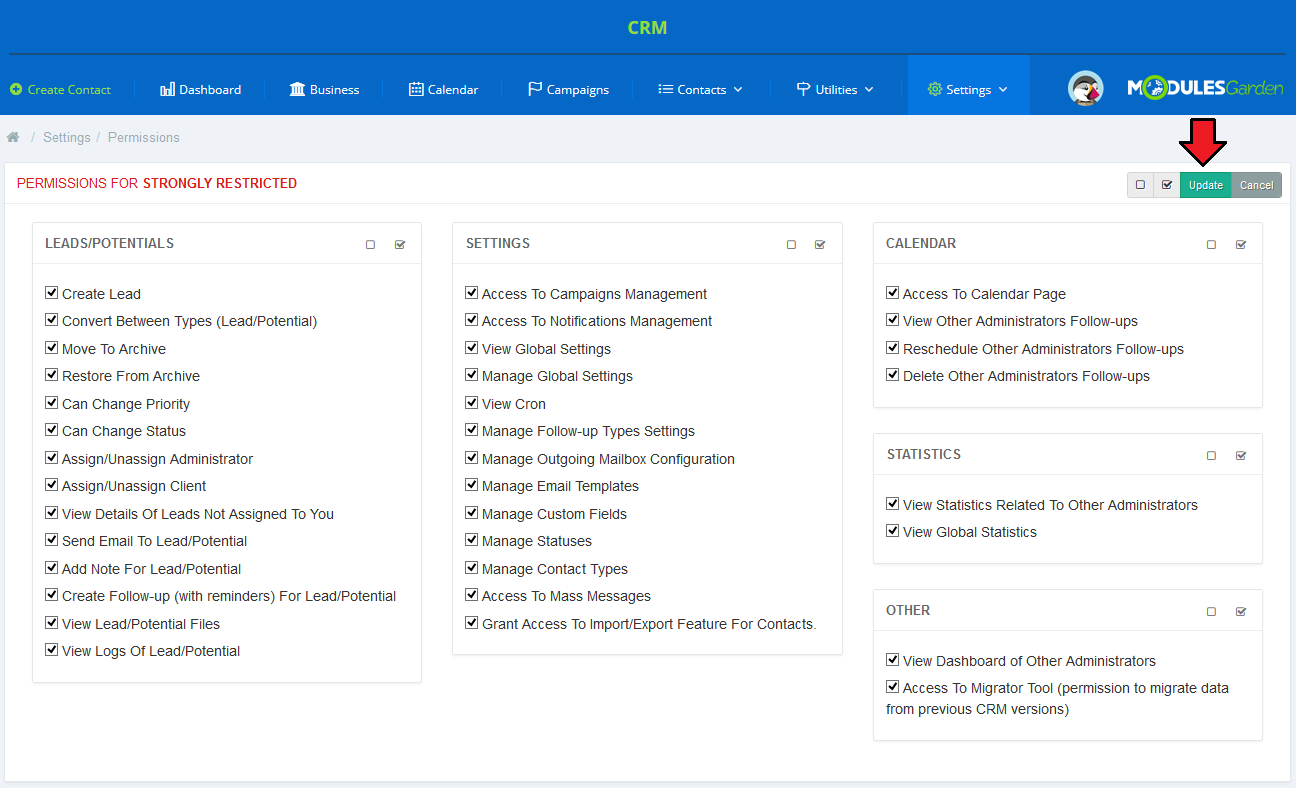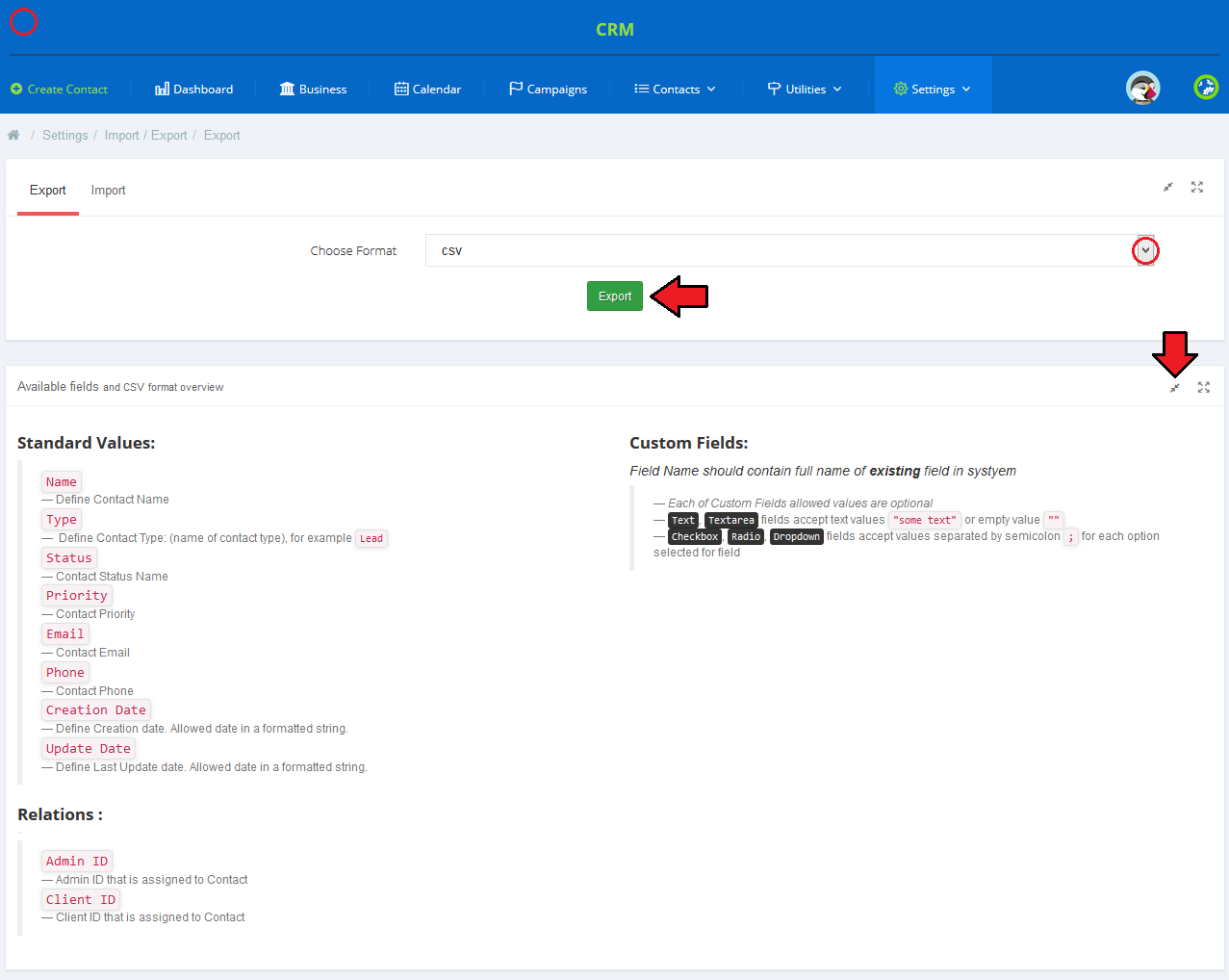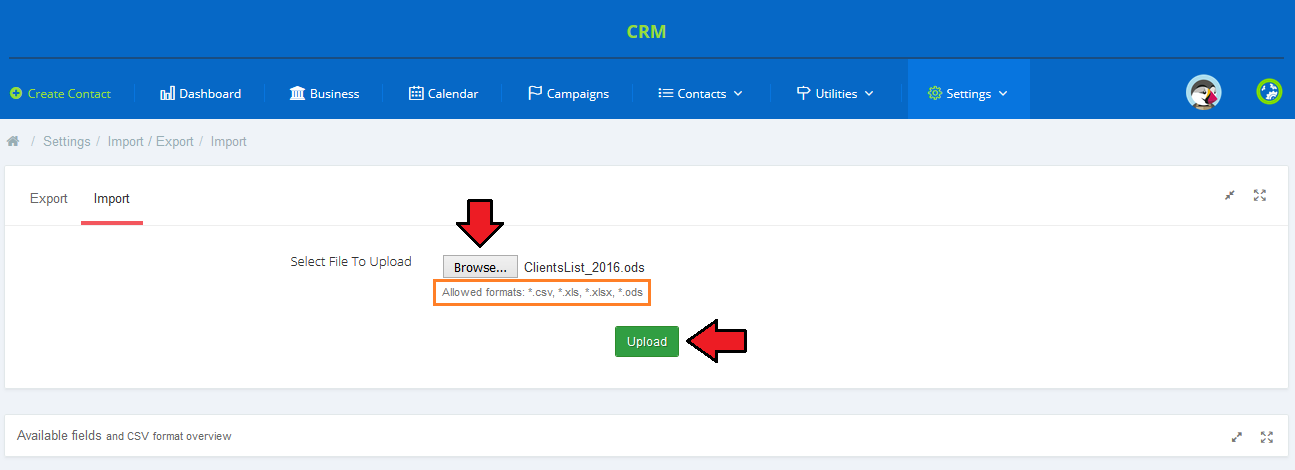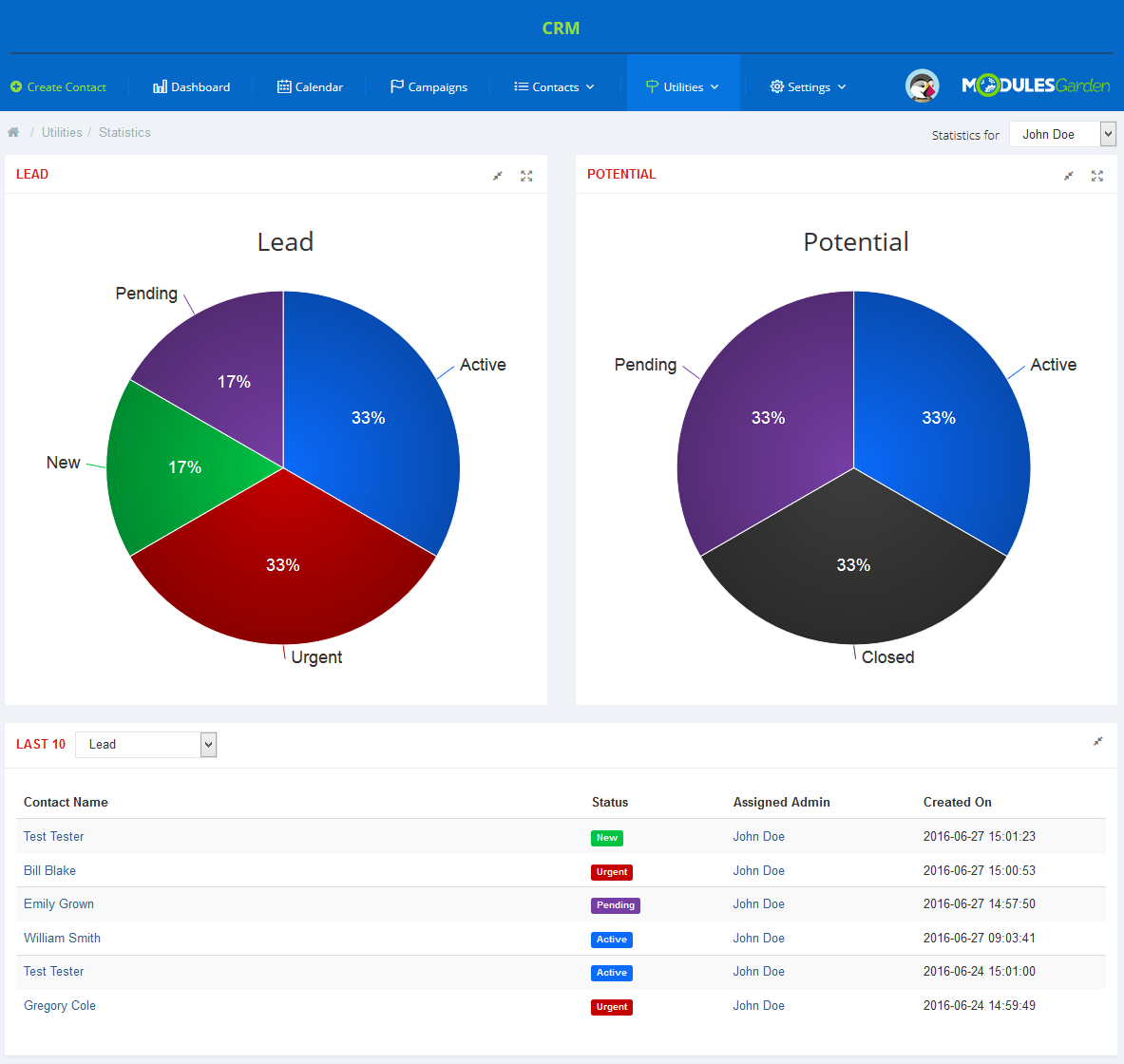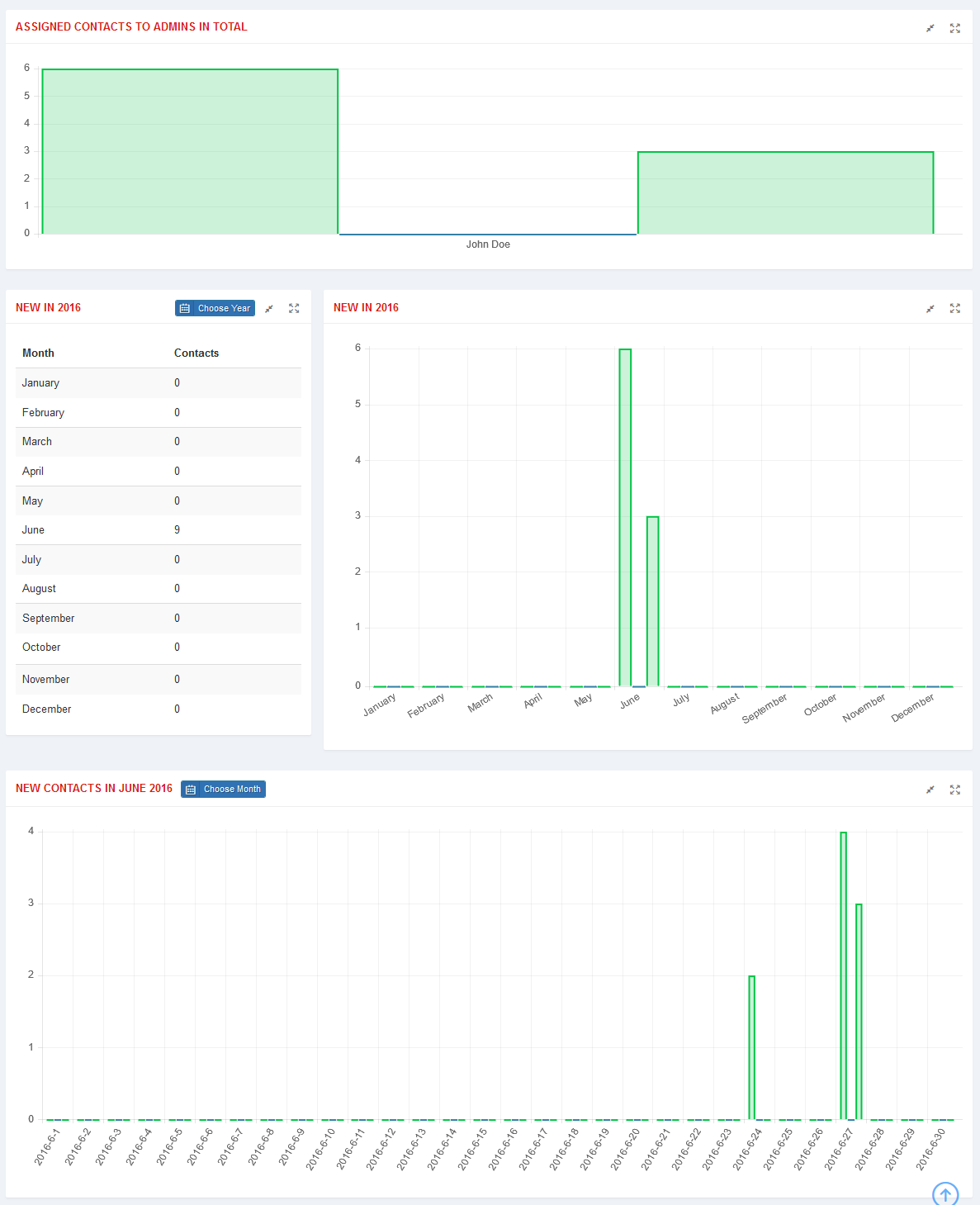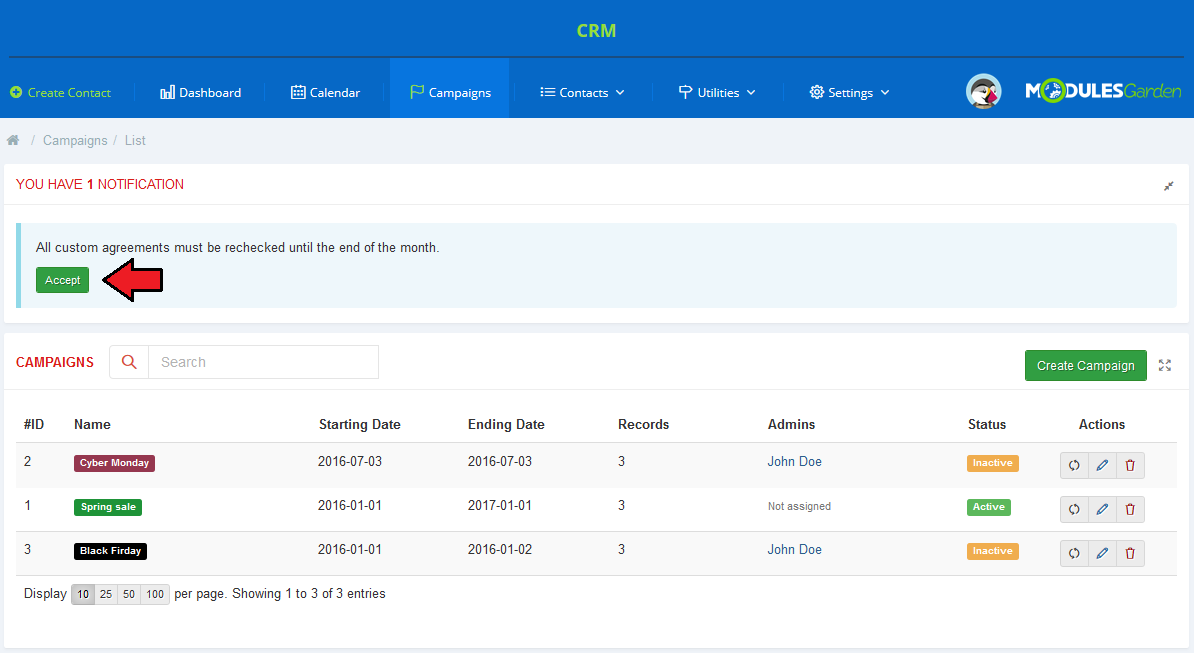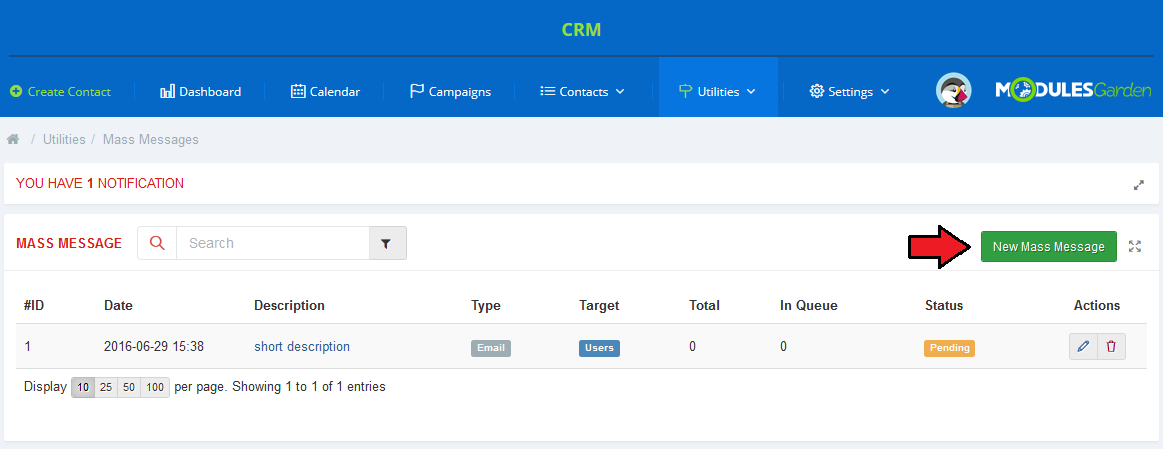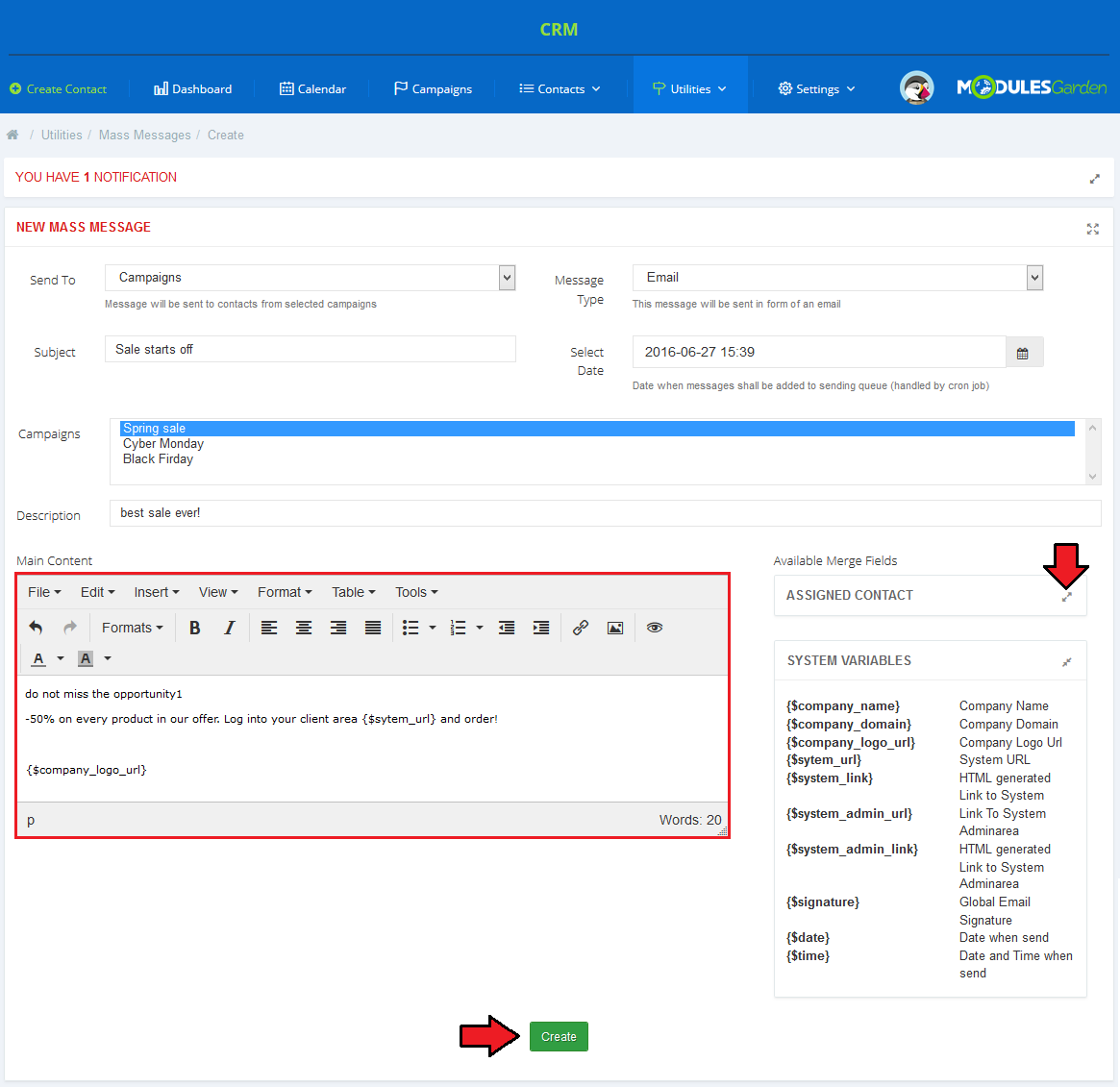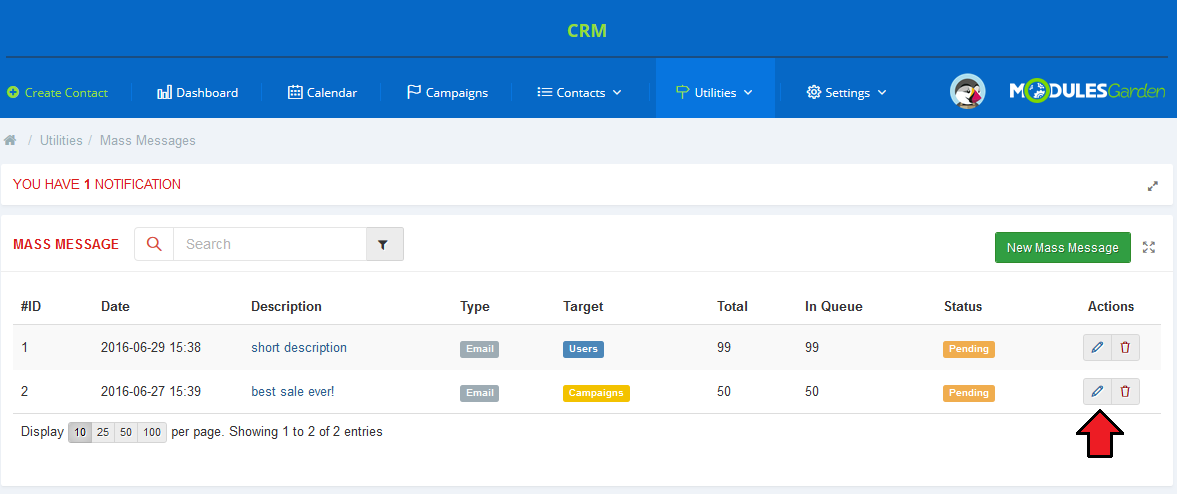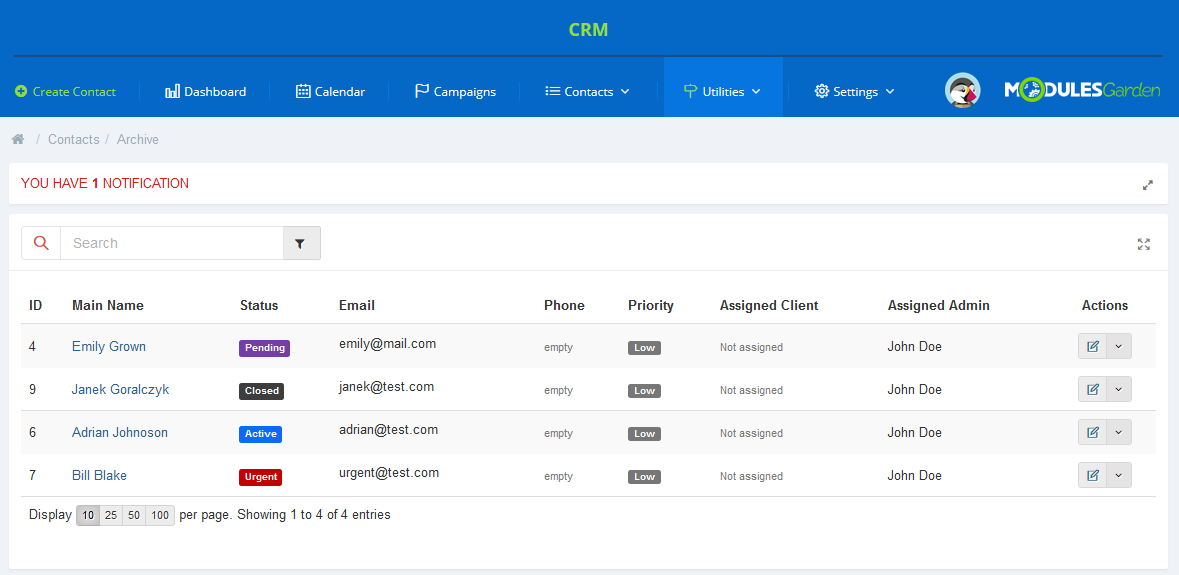Hosting Quota Notifications 1.X For WHMCS
From ModulesGarden Wiki
(Difference between revisions)
|
|
| Line 238: |
Line 238: |
| | {| | | {| |
| | |style="padding: 0px 0px 15px 15px;"|'''5. Now you have to activate the module on your PrestaShop platform. '''<br /> | | |style="padding: 0px 0px 15px 15px;"|'''5. Now you have to activate the module on your PrestaShop platform. '''<br /> |
| − | Log in to your PrestaShop admin area. Go to '' 'Modules and Services' '' → '' 'Modules and Services'. '' Afterwards, find '' 'MG CRM2' '' on the list of modules and install it. | + | Log in to your PrestaShop admin area. Go to '' 'Modules and Services' '' → '' 'Modules and Services'. '' Afterwards, find '' 'CRM' '' on the list of modules and install it. |
| | |} | | |} |
| | {| | | {| |
| Line 273: |
Line 273: |
| | You can access your module in '' 'PrestaShop' '' → '' 'CRM'. '' | | You can access your module in '' 'PrestaShop' '' → '' 'CRM'. '' |
| | |} | | |} |
| − |
| |
| | | | |
| | =Configuration and Management= | | =Configuration and Management= |
Revision as of 08:57, 28 June 2016
An update of this article will be available soon, please watch out for broken links and unclear descriptions!
We are sorry for the inconvenience caused.
CRM For PrestaShop will introduce customer relationship management into your eCommerce platform to let you handle your contacts and follow-ups automatically.
You can divide your contacts between leads, potentials and other personalized types. Organize campaigns, send notifications, add notes, upload files, manage mailboxes and many more.
What is more, the module allows the option to import/export details on your contacts to backup the data or migrate them between PrestaShop systems.
|
| ✔ Contacts From Chosen Campaigns
|
| ✔ Convert Contact Types Between Lead And Potential
|
| ✔ Assign Client Account To Contact
|
| ✔ Assign Administrator To Contact
|
| ✔ Quickly Edit Contact Details
|
| ✔ Add And Manage Contact's Follow-ups
|
| ✔ Add And Manage Contact's Notes
|
| ✔ Create And Manage Email Templates
|
| ✔ Send Email From Template Or Custom Message - Include Files
|
| ✔ Create And Manage Outgoing Mailboxes
|
| ✔ Upload And Manage Files From Contact Profile
|
| ✔ View Announcements For Administrators
|
| ✔ View Logs Concerning Contact
|
| ✔ View Dashboard Containing Incoming Follow-ups
|
| ✔ View Calendar With All Reminders Sorted By Type
|
| ✔ View CRM Statistics And Graphs Concerning Contacts
|
| ✔ Import Contacts In Chosen File Formats: CSV, XSL, XSLX and ODS
|
| ✔ Export Contacts In Chosen File Formats: CSV, XSL, XSLX, ODS and PDF
|
| ✔ Upon Removing, Contact Is Moved To Archive Where They Can Be Restored From If Needed
|
| ✔ 3 Types Of Notifications: Now, On Follow-up Date, Before Follow-up Date - Both For Administrators And Clients
|
| ✔ Follow-up Type - Easier Determination Of Follow-up Purpose
|
| ✔ Administrator To Notify - Defines Included Administrators Per Notification Type
|
| ✔ Notify Administrator via Email
|
| ✔ Use Email Template Or Place Custom Message
|
| ✔ Define Campaign Duration Time
|
| ✔ Assign Leads To Campaign Using Filters
|
| ✔ Manually Assign Campaign To Lead
|
| ✔ Display Dashboard Per Campaign
|
| ✔ Display Campaign Description Inside Of Assigned Lead Profile
|
- Module Settings Features:
| ✔ View Module Status - Contains Status Of CRM Key Elements
|
| ✔ Define Whether To Use Quotes And Administrator Assignment
|
| ✔ Define Follow-up Types And Default Notifications On Follow-up Reschedule
|
| ✔ Define Temporary And Permanent Notifications For Administrators
|
| ✔ Define If Notification Needs To Be Acknowledged By Administrators
|
| ✔ Create Custom Fields - Text, Textarea, Checkbox, Radio And Select
|
| ✔ Add Description To Custom Field
|
| ✔ Add Validators To Custom Fields
|
| ✔ Define Custom Contact Types:
|
| ✔ Define Contact Type Color And Icon
|
| ✔ Define Contact Type Visibility On Navigation
|
| ✔ Define Permissions Per Administrator Role Group
|
| ✔ Define Personal Settings:
|
| ✔ Define Visible Fields And Their Order For Leads, Potentials And Dashboard
|
| ✔ Configure Default View Of Leads And Potentials Lists - Visibility And Order In Columns
|
| ✔ Create CRM Email Templates
|
| ✔ View Information About CRM Cron
|
| ✔ Requires Ioncube Loaders V4.0 or Later
|
| ✔ Standalone Mode - Display CRM Outside Of PrestaShop
|
| ✔ Display Any Page Or Panel In Full Screen Mode
|
| ✔ Supports PrestaShop 1.6.1.2 and Later
|
Installation
This tutorial will show you how to successfully install and configure CRM For PrestaShop.
We will guide you step by step through the whole installation and configuration process.
|
Installation
| 1. Log in to your client area and download CRM For PrestaShop.
|
2. Upload and extract the module into the main PrestaShop directory.
Files in your PrestaShop directory should look like on the following screen.
|
3. When you install CRM for the first time you have to rename 'license_RENAME.php' file.
File is located in 'modules/mgCRM2/license_RENAME.php'. Rename it from 'license_RENAME.php' to 'license.php'.
|
4. In order to configure your license key, you have to edit the previously renamed 'license.php' file.
Enter your license key between quotation marks as presented on the following screen. You can find your license key in your client area → 'My Products'.
|
Activate The Addon
5. Now you have to activate the module on your PrestaShop platform.
Log in to your PrestaShop admin area. Go to 'Modules and Services' → 'Modules and Services'. Afterwards, find 'CRM' on the list of modules and install it.
|
6. Confirm the installation.
|
7. In the next step you need to configure permission settings.
To do so, click on 'Configure' button. select desired admin roles and save the changes.
|
8. Select desired admin roles and save the changes.
|
7. Now, you have to set up a cron job, which can be found in 'CRM' → 'Settings' → 'General' → 'System Overview'.
We advise to set up the cron as frequently as possible to send email notifications, 5 minutes interval is recommended.
|
8. You have just successfully installed CRM For PrestaShop!
You can access your module in 'PrestaShop' → 'CRM'.
|
Configuration and Management
| CRM For WHMCS is a module which allows you and your staff to manage relations with your current as well as possible clients in one place.
|
Dashboard
| When you proceed to 'Addons' → 'CRMv2', you are automatically moved to the application dashboard.
From there you have a quick preview of the most important information in your CRM.
View follow-ups on calendar, list of latest leads/potentials and last activities.
|
It is possible to adjust the dashboard view according to applied filters. Choose dashboard view of CRM for a selected administrator.
Select '--Any' if you want to show all content. Select 'Not Applied' if you want to clear the filtering.
|
Contacts
Create Contact
| To create a new contact press button marked on the screen below.
|
You are moved to a contact creation form. As you can see below, fields are divided into two sections: Options and Information.
Fill out the form and press 'Add' to add the contact to the list. There may be visible some custom fields if they have been added and enabled.
Note: Only staff members with full privileges can assign admins to the contacts.
|
Immediately, after a new contact is added you are moved to its summary, where you can find/edit some additional data.
Read more about them in the following section.
|
Manage Contacts
In 'Actions' column you can find various useful operations which can be performed on a contact.
As you can see, in dropdown menu, actions such as 'Convert To Potential' and 'Move To Archive' can be found.
|
Now, let's proceed to the contact itself.
Press pencil icon to move to the contact's summary page.
|
Summary
To edit any of the options in the contact summary page, simply press a pencil icon that appears when you hover you mouse cursor on the option.
In this way you may reassign the administrator, alter the name and change the current status. Mark appropriate number of stars to change the contacts priority:
- Low
- Medium
- Important
- Urgent
|
| Aa mentioned above, when you press the pencil icon, you may select current status, choose from (deafult):
Every time you are editing any information please press the green confirmation button to save teh changes.
|
Module allows assignment of a client account to the contact.
This can be done in two ways, by creating a new client from a contact or by selecting an existing client to a contact.
|
When you hover over email address, two icons appear. Press the first one and you will be redirected to a section where you can send email messages from.
When you decide to edit (2.), simply type in the new address.
|
Just like in case of any other option in this section, you may assign your contact to any campaign if such exists.
When assigned, campaign details appear in a separate widget.
|
In 'Summary' page you may also find a brief conclusion on cerated notes, list of flow-ups and quickly do actions like:
- adding new notes
- sending emails
- adding follow-ups
- sending tickets responses (if assigned)
|
Follow-ups
Follow-ups allow you to send email templates or text messages to contacts and staff members, and create ToDo entries.
|
Any follow-up can be rescheduled (1.), edited (2.) or removed (3.) using buttons in the 'Actions' column.
You can search for the desired follow-up using search box and sorting by one of the columns.
|
To add a new follow-up, fill out the 'New Follow-up' form.
Here you can define:
- Date - (required) time when the notifications will be sent.
- Description - (required) short description of a follow-up, it will be afterwards visible in the follow-up list.
- Follow-up Type - allows you to define the type of a follow-up for easier determination of its purpose.
- Admin - admin whom ToDo entry will be assigned.
|

|
| The last step is defining reminders, we will discuss each of them below.
Reminders for Administrators
- 'On Create' - Notification is sent to an admin, who is assigned to a contact, immediately when a follow-up is created.
- 'Follow-up Due Date ' - notification is sent to an admin, who is assigned to a contact, on the set date.
- 'Before Follow-up Due Date ' - Specify time (date/hours/minutes etc) before the Follow-up Due Date to send notification to an admin, who is assigned to a contact.
Reminders for Clients
- 'On Create' - Notification is sent to a client, who is assigned to a contact, immediately when a follow-up is created.
- 'Follow-up Due Date ' - Notification is sent to a client, who is assigned to a contact, on the set date.
- 'Before Follow-up Due Date ' - Specify time (date/hours/minutes etc) before the Follow-up Due Date to send notification to a client, who is assigned to a contact.
|
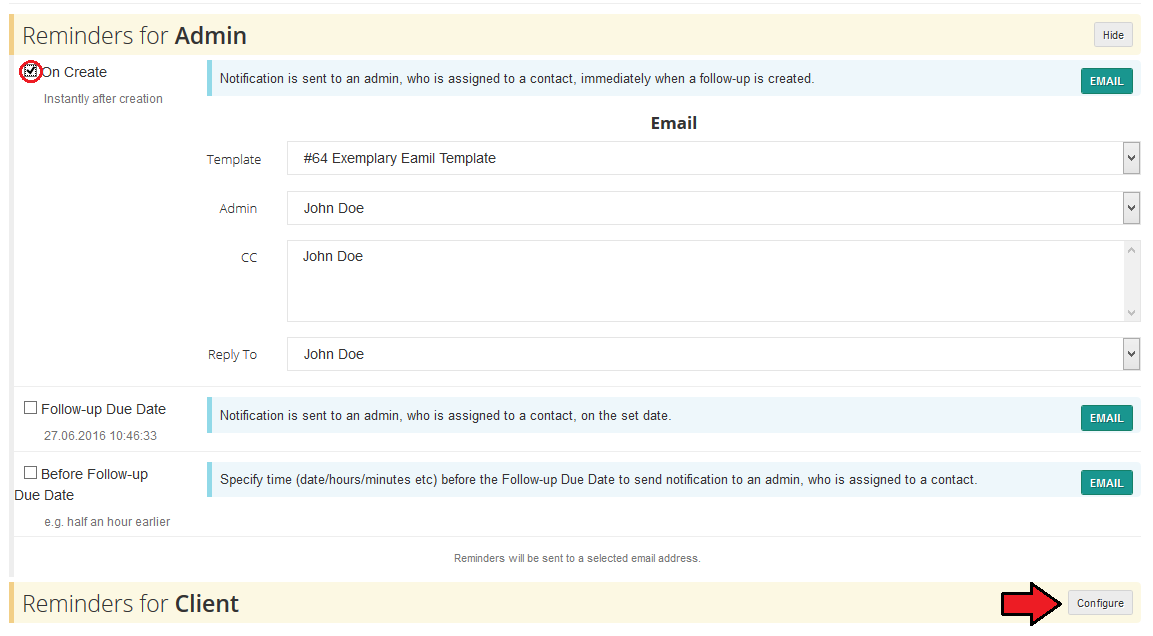
|
| Added follow-up will turn up on the list of all follow-ups of the lead. Use action buttons to delete the follow up, reschedule and edit.
|
| In order to reschedule a follow-up you must always give the reason!
|
Edit follow-up details:
- edit details
- add reminders
- manage existing reminders
|
Notes
'Notes' enables you to make and manage notes about the contact.
On the following screen you can see how to add an exemplary note.
|
| Any existing note can be modified, hidden or deleted. Hover over the note to see the action buttons.
|
Emails
Any staff member can send an email from the contact's profile.
As you can see, you can manually fill out email subject, content and files to attach.
|
| Alternatively, you can choose one of email templates to send.
|
Orders
Move to orders page where you can place orders for the contact. When you press 'Add New Order' and you will be redirected to your PrestShop page where orders can be placed.
Preview details of all orders and edit them if required.
|
Files
'Files' tab allows you to upload and manage files related to your contact.
To upload a new file, select file to upload and describe it shortly, press 'Upload'.
|
Any uploaded file can be downloaded from the CRM by pressing its name or using actions icons.
It can be also removed by clicking on dustbin icon.
|
Logs
To view the latest actions performed on the contact, go to 'Logs' tab.
As you can see, it contains all details you might want to find in the logs.
|
'Logs' page, apart form displaying all the logs concerning the contact, contains searchbox.
Using the search option you can find logs of actions performed by specific administrators, at desired time and concerning desired actions.
On the following screen we were searching logs of associated with any event on client.
|
Calendar
Access calendar tab and you will find a fully manageable and adjustable calendar.
Switch between days, moths and week views to have a clear and precise view on your scheduled events (click on a selected day to see details).
Month view:
|
Under the calendar, there is a detailed legend of visible items with enumerated types of follow-ups.
Click on any follow-up to see its details.
|
Campaigns
Another functionality that CRM For WHMCS has to offer is the possibility to create customized campaigns.
If you decide to apply this option, you will be able to create many and varied campings with selected contacts included and filtered according to your personal configurations.
Let's check how this functionality works.
|
Add Campaign
| In order to add a new campaign use 'Create Campaigns' button.
|
Start with filling out some basic data about the campaign such as its name and descriptions. Select color that will be used to distinguish items.
Assign admins who will have access to the campaign entries and declare beginning and ending dates.
|
In the second part you need to select filters to assign wanted record to this campaign. You may use both predefined system fields and your custom fields.
Finally 'Add Campaign'.
|
Campaigns List
Find all the created campaigns stored together on a convenient list with the most crucial data close at hand.
Use Action buttons to:
1. Manually force record reassignment
2. Move to edition page
3. Delete unused campaign
|
Settings
Due to the wide variety of possible configurations, 'Settings' section has been moved to underneath to make the presentation more precise.
In 'Settings' → 'General' page of the module you can check current module status, enable major features and define follow-ups' settings.
|
General
System Overview
Under System Overview you can find information about:
- Integration with Asterisk VoIP Center For WHMCS
- Integration with SMS Center
- Cron job setup
- Number of CRM email templates
- Storage folder used by the module
In 'Cron Details', you can find all the information about the cron such as its path, last execution date and interval between cron runs.
|
Options
| In Additional Options quotations may be enabled for leads and potentials as well as possibility to assign leads to administrators.
|
Follow-ups
In the next section of General Settings there are basic options to configure follow-ups.
In settings part, you may enable follow-up per day (it means that a follow-up can be added within a day, not a specific hour)
and choose email template used to notify admins about a follow-up being rescheduled.
|
| Add new follow-up type by entering its name, assigning a color and finally enabling it to use. Once added you will see in the list of available underneath.
|
Personal
Personal Settings
| Provide a URL to your avatar to personalize your CRM as you only wish!
|
Fields' View
In this place you may decide which columns exactly and even in what order they will appear in each of the possible sections
(Contact's page and Dashboard). Click on each section one by one to set its view.
Drag and drop available fields to create a perfect configuration.
|
Mailbox
Outgoing Mailbox Configuration
| create mailbox. dokałdny opis
|
Email Templates
| list of tempaltes/edit/delete
|
Add New Template
| add new template, press as shown
|
Fields
Manage 'Fields' fully, add new fields, group them, define statuses and map existing fields.
|
List Of Fields
Each field, regardless of its type, has its name, description, assigned group and obviously its type.
Available types and validators for each of the types (seen when editing existing field)
- text: required, min, max, email, url, ip, regex
- textarea: required, min, max, regex
- radio: required, min, max
- checkbox: required, min, max
- select: required, min, max
On the following screen you can see an example of a dropdown type custom field.
To add a field, press 'Create Field'.
|
Groups
Place where groups to segregate fields are created. Once you already know how you want to group your fields, create an adequate groups.
Name them, assign a color and enable to start using it.
|
Status
Exactly, just like in case of groups, you may add hare statuses that later on will be used to segregate fields.
Name the new status, assign a color and enable to start using it.
|
Contact Types
'Leads' and 'Potentials' are the only predefined contact types that are available from the beginning you start using your CRM.
However, to make our CRM for WHMCS even more customizable and user friendly we have implemented a function which allows creating new contact types and their full management.
|
Add New
To add a new type simply fill out the visible on the screen below form.
- Enter its name and choose color
- Enter icon code - the icon will be always visible next to this contact type name, remember to use available formats, e.g.: 'fa fa-empire', 'fa fa-plus-circle '
- Visibility in navigation bar - choose whether you wish to have the new contact type visible on the main navigation menu and submenu (under 'Contacts' tab)
- Dashboard - if you select this option, the new type will be visible on dashboard, and you will be able to filter the view by this type.
Press 'Add' button to finish the process.
|
Contacts Management
Under the creation form, there is a list of all available in your CRM contact types, together with the predefined 'Leads' and 'Potentials'.
Here you can fully customize your contact by:
- changing assigned color or icon,
- turning on/off its availability in navigation menus and dashboard
- activating/deactivating the contact
- deleting useless types.
Important!
Any changes made in this section require reloading the page or clearing browser cache! Changes to contact types are not instant.
|
If you want to delete a contact type, you will be asked to choose another type to which any contacts of the deleted type will be reassigned to.
If you do not want to reassign the contacts to another type, you can move them to the archive, to do so, simply select 'Move to Archive' option.
Still, you will have to choose a type for contacts. It will be used in case you decide in future to restore these contacts from the archive.
|
Permissions
| The last section in 'Settings' is responsible for assigning permissions to certain roles of group of administrators.
Select permissions for each existing role.
|
Once you have added a new role, use actions buttons to move the page where you can choose single permission rights for the group.
Select the one you need and 'Update' the settings.
|
Import/Export
Export File
In order to export a file from your CRM system, simply choose a target file format (CSV, xls, xlsx, ods or pdf) and press 'Export' button.
A file with a list of contacts available in your system with their details such as name, type, priority, phone etc will download shortly.
A list of available fields that can be included in the file to either import or export are available underneath.
Important!
It is required that you use only the fields that are visible underneath. In case you name your columns in any other way, the import action will fail!
|
Import File
In order to import a file to your CRM system, simply select a file from your disc and press 'Upload' button.
A file with uploaded list of contacts will be available shortly.
Note: you can upload files of 'pdf', 'csv', 'xls', 'xlsx' or 'ods' format only.
|
Utilities
Statistics
| 'Statistics' contains graph concerning your leads and potentials.
Among the graphs, there can be distinguished graphs showing for example: the number of Leads and Potentials per status, new contacts per admin, per month and per day.
Additionally, administrators with extended permissions are able to view statistics of chosen administrators.
In 'Statistics' you can find the overall information such as graphs on Leads and Potentials of chosen status.
See a list of recently added leads/potentials with details such as assigned admins, status or creation date.
|
| There are graphs and statistics tables presenting number of leads/potentials added within certain periods of time (year/month)
|
Notifications
In this part you can manage any notifications that shall be delivered to any administrator depending on the configuration.
Let's check how it works. Press 'Create Notification' to begin.
|

|
You are moved to 'New Notification' creation form. Fill out the data to tailor the notification base perfectly in accordance with your needs.
- Choose its 'Type' from 'Temporary' and 'Permanent'.
- Select importance: 'Normal', 'Information', 'Warning' and 'Danger'.
- Mark administrators that this notification will be displayed to. You may surely select more than one admin.
- In 'Message' field simply type in the text of the notification. It is allowed to use HTML code here.
- Select 'Starting' and 'Ending' dates for 'Temporary' notifications
- 'Confirmation' - if you select this box, administrator will have to confirm reading such notification by pressing 'Accept' button.
- The button will be visible on the notification
- 'Hide Once Accepted' - decide whether accepted notification should disappear from the widget
'Create Notification'.
|
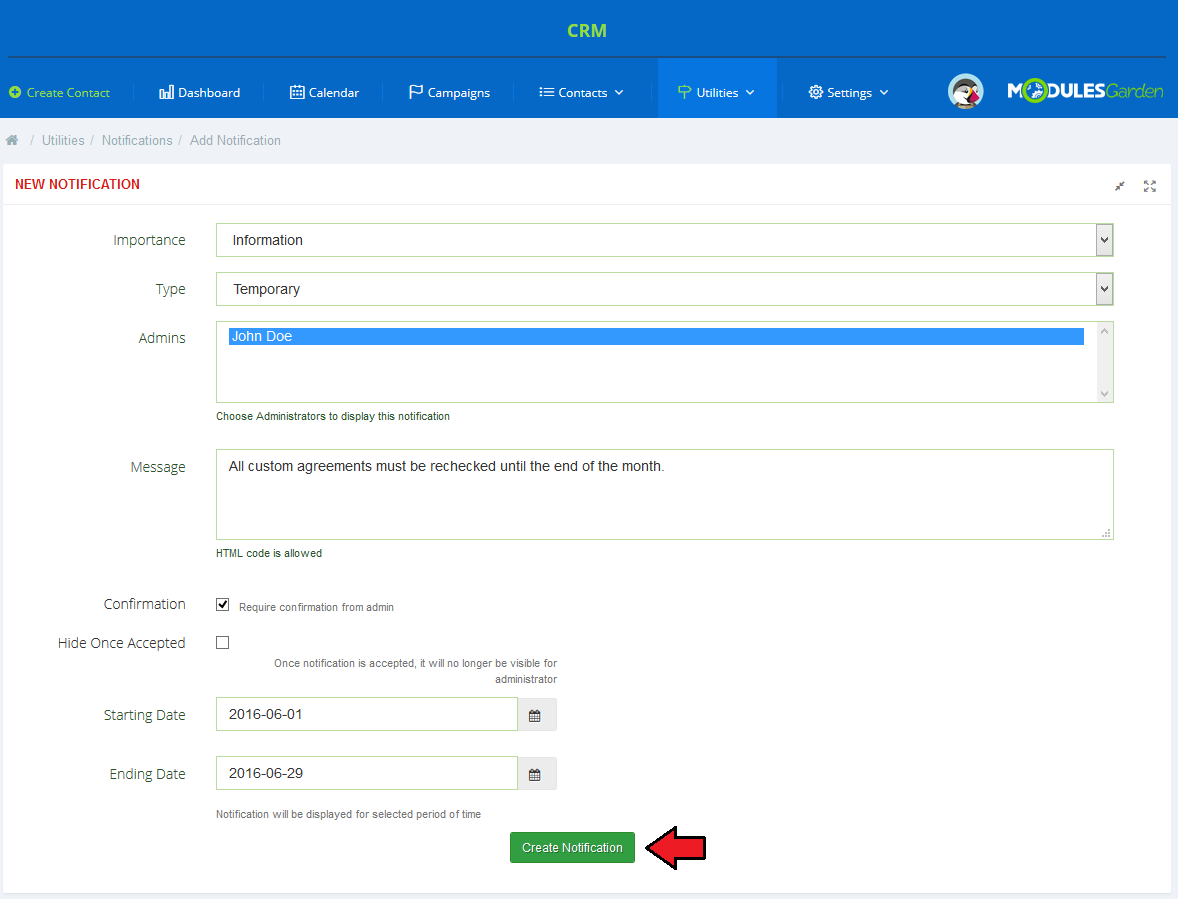
|
A newly created notification form is now visible on the list of all notifications in the system.
You may easily edit the notification (you will be moved to creation form where you can make any changes) or delete useless notification.
You will see here information if notifications have been accepted by administrators (if required) and by which ones exactly.
|
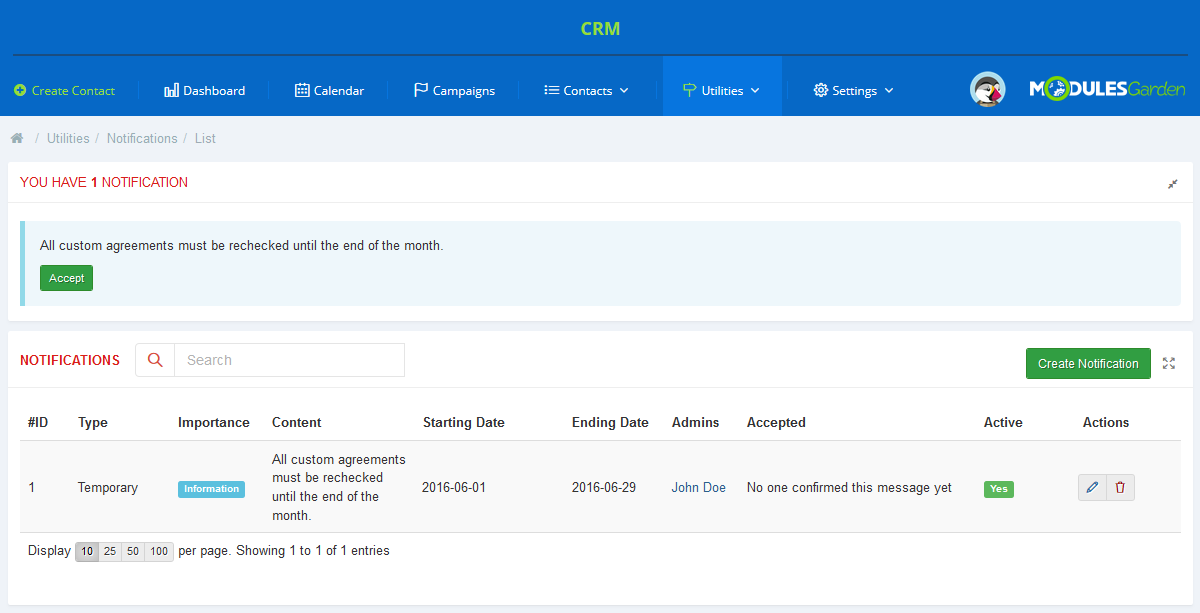
|
Created notifications are visible for selected in the configuration admins on any page of their CRM system.
'Accept' your notifications if it is required. Such info boxes like on the screen below will be visible until the specified in the configuration 'Ending Date',
or once accepted if 'Hide Once Accepted' option has been selected.
You may easily hide it by pressing icon in the top right corner of the widget.
|
Mass Messages
Configure mass messages templates that can be used in your campaigns!
Press 'Create Mass Message' and fill out the template form.
|
- Choose a group the messages will be delivered to, these can be single users, groups of users or campaigns.
- Select message type: email or SMS (if integrated with SMS Center For WHMCS)
- Enter subject of the message
- Select date when messages will be placed on the list to send (triggered by cron)
- Select user groups/users or campaigns (depending in the chosen target)
- Describe the template shortly
- Create the message
- Enter the main content of the message, use an advanced tool to edit the input (email only) and available merge fields.
|
Once added, mass message template will be visible on the list. You will find there short info on each template.
Use action buttons to edit or remove a template.
|
Archive
| List of unused leads/potentials. Use action buttons to edit entries and convert them back to lead or potential from the archive.
|
Additional Information
| A full list of supported variables for reminders and email templates:
|
Email Templates:
- {$resource.client.id}
- {$resource.client.firstname}
- {$resource.client.lastname}
- {$resource.client.email}
- {$resource.id}
- {$resource.name}
- {$resource.status_id}
- {$resource.email}
- {$resource.phone}
- {$resource.piority}
- {$resource.type_id}
- {$resource.admin_id}
- {$resource.client_id}
- {$resource.ticket_id}
- {$resource.created_at}
- {$resource.updated_at}
- {$resource.deleted_at}
- {$resource.status}
- {$fields.<fieldID>.id}
- {$fields.<fieldID>.type}
- {$fields.<fieldID>.active}
- {$fields.<fieldID>.name}
- {$fields.<fieldID>.description}
- {$fields.<fieldID>.data}
- {$company_name}
- {$company_domain}
- {$company_logo_url}
- {$whmcs_url}
- {$whmcs_link}
- {$whmcs_admin_url}
- {$whmcs_admin_link}
- {$signature}
- {$date}
- {$time}
|
Tips
1. If you want to see a specific part of your CRM, a single widget only, use full screen mode for widgets.
- You will find it in the top right corner of each widget.
|
Common Problems
| 1. When you have problems with connection, check whether your SELinux or firewall does not block ports.
|
2. In case you have problems with your CRM, for example empty tables, no follow-ups in calender or you cannot add new status, group, follow-up, then please make sure that
your .htaccess or vhost do not block the module in any way.
Underneath there is an exemplary input of a .htaccess file, which will unblock the connections and methods:
RewriteCond %{REQUEST_FILENAME} !-f
RewriteCond %{REQUEST_FILENAME} !-d
RewriteRule ^(.*)crm.php(.*)$ /admin/crm.php [QSA, L]
<Limit PUT DELETE OPTIONS>
Order allow,deny
Allow from all
</Limit>
Please note that admin file may have a custom name, remember to adjust the file input to your naming.
|
|
